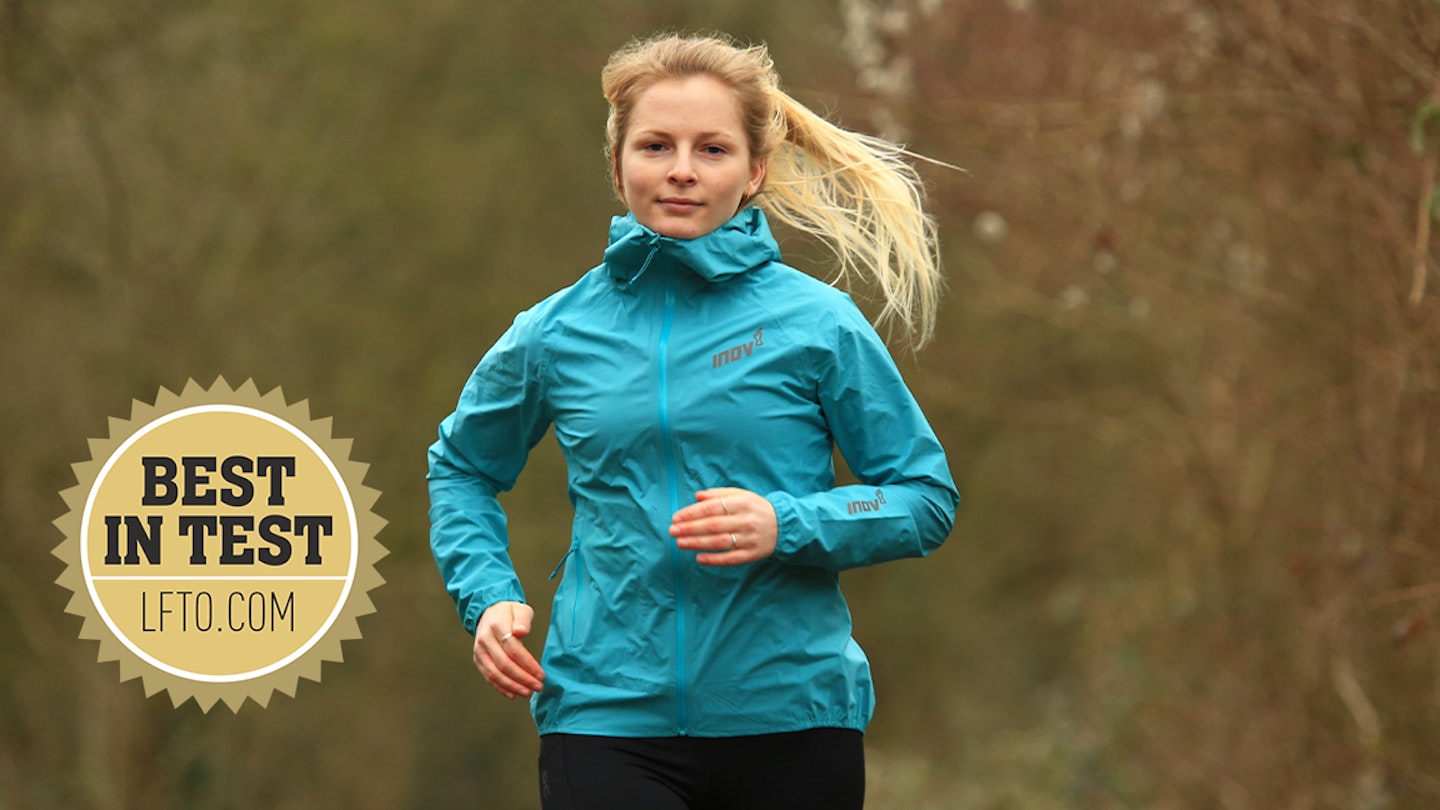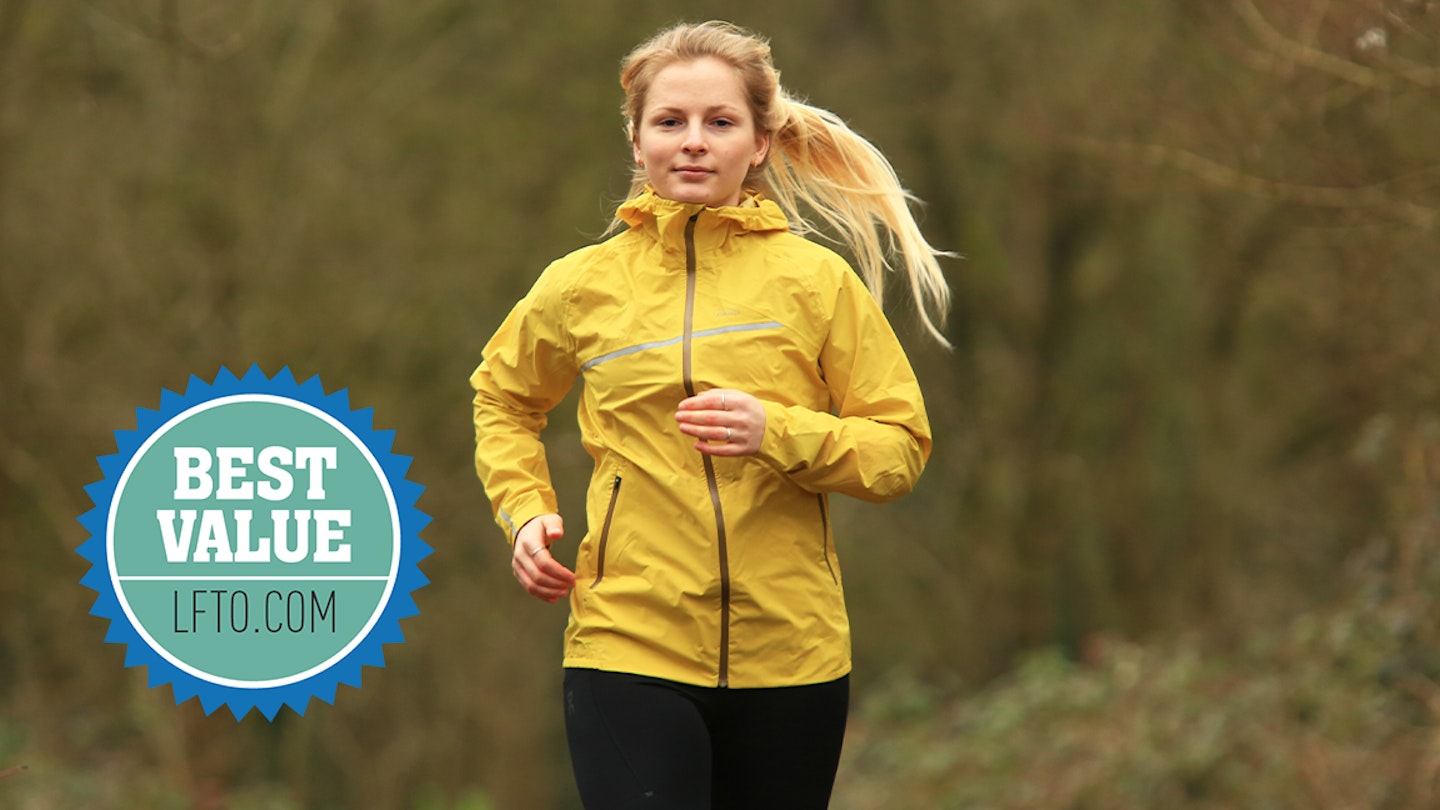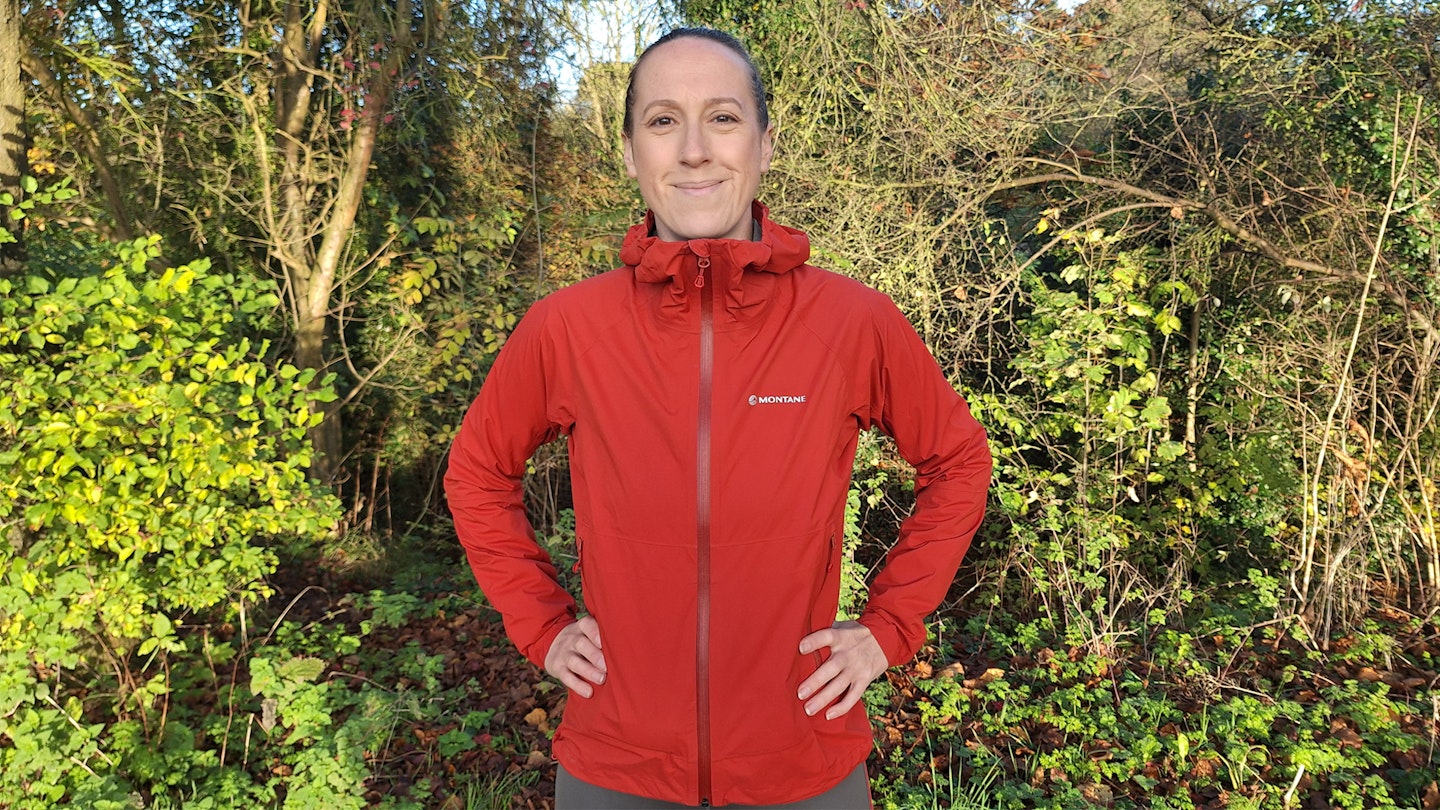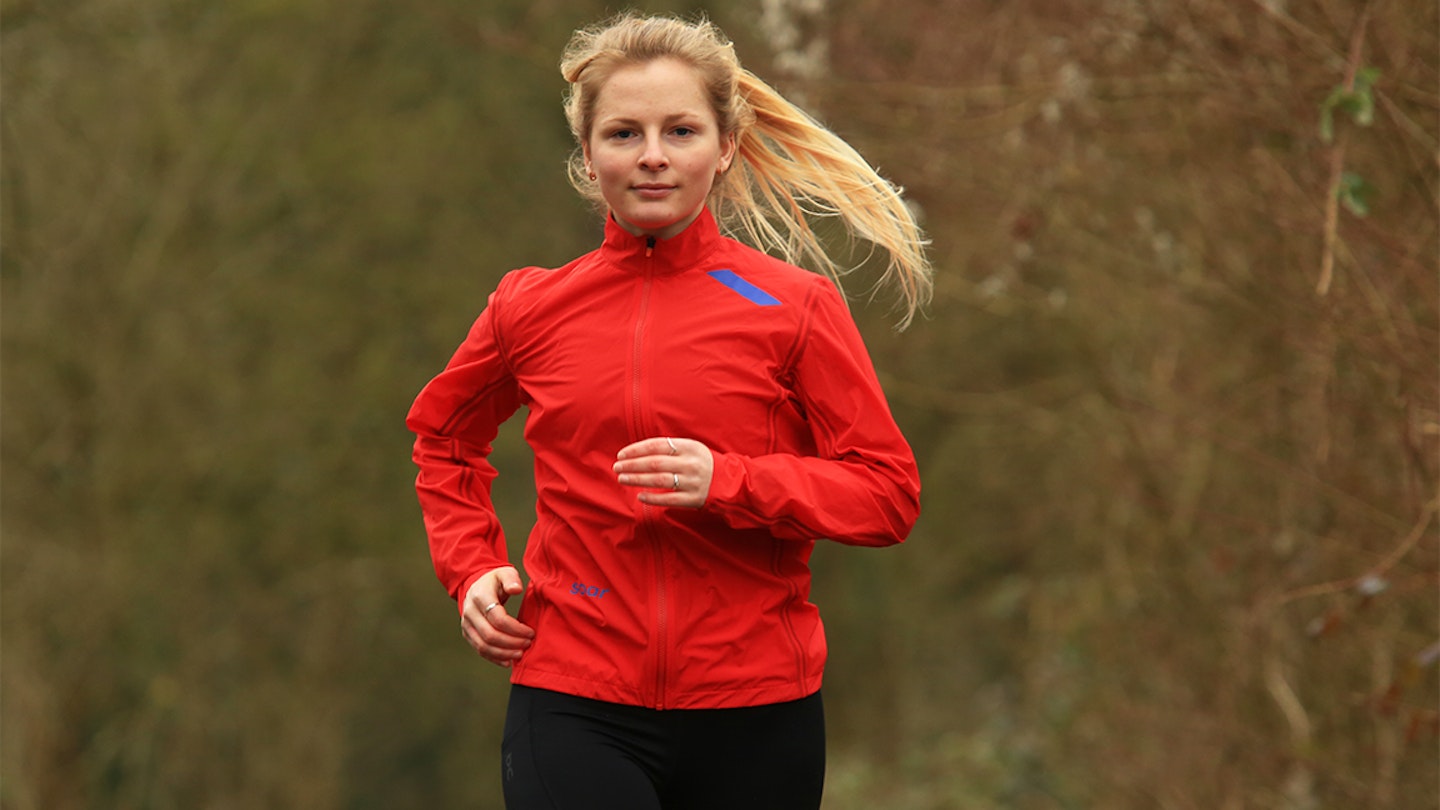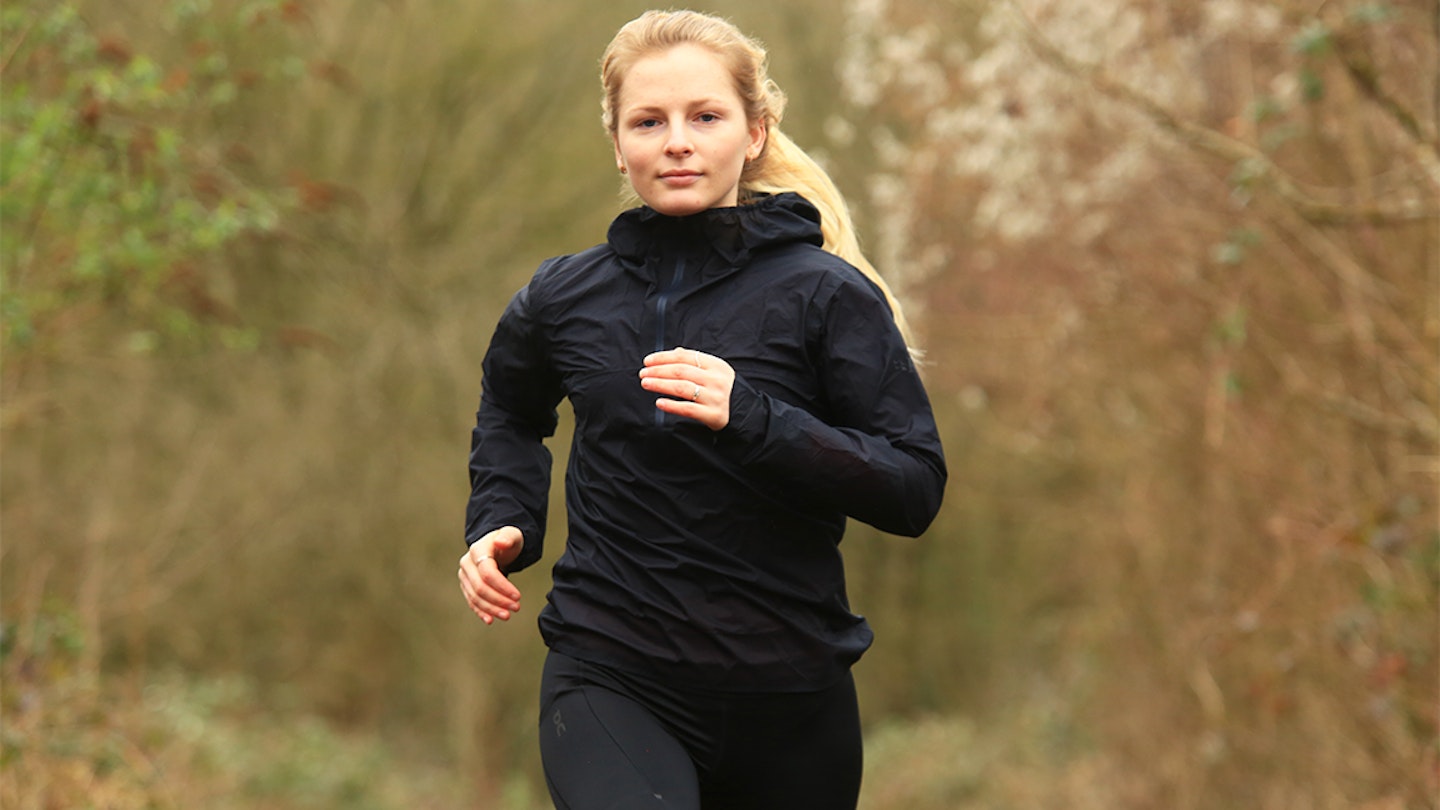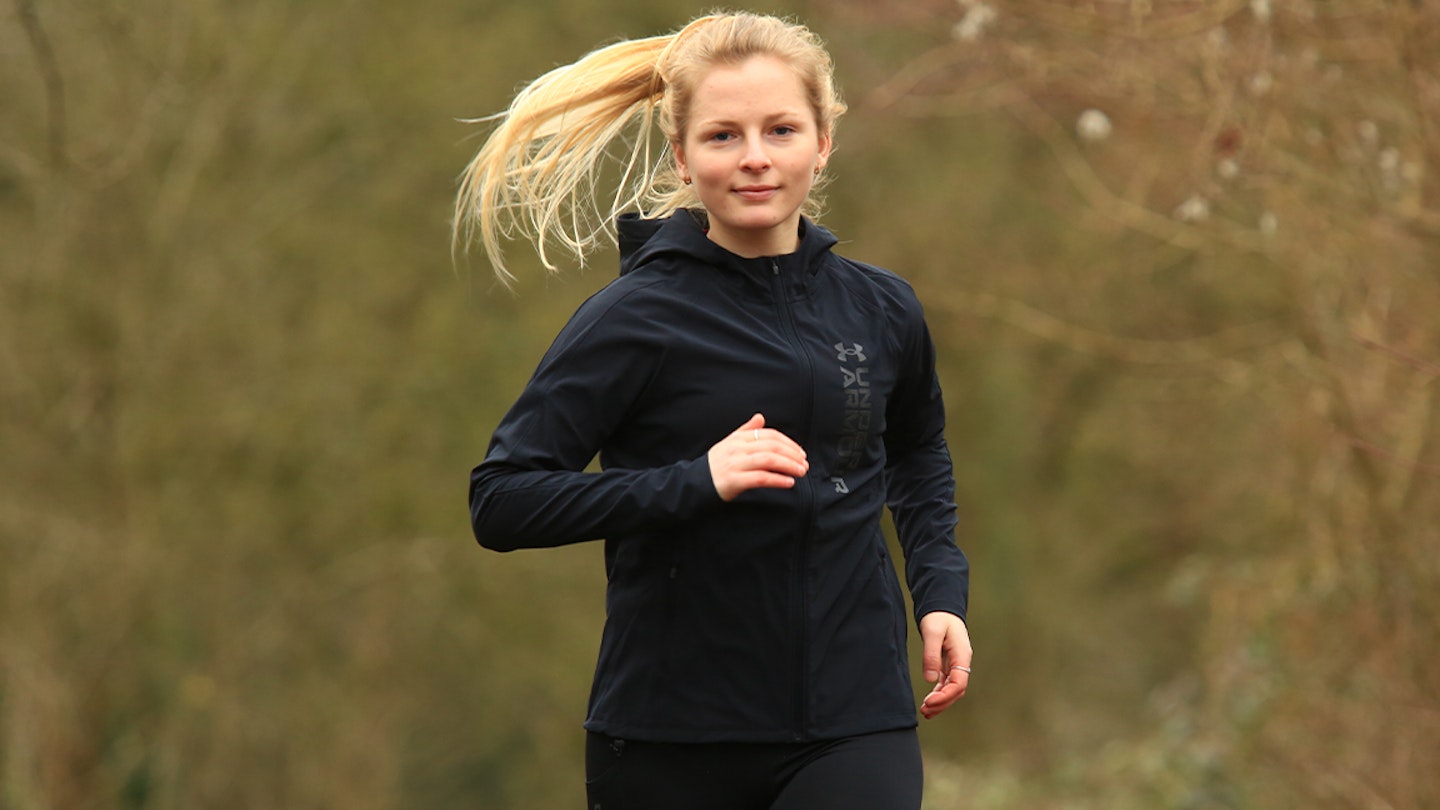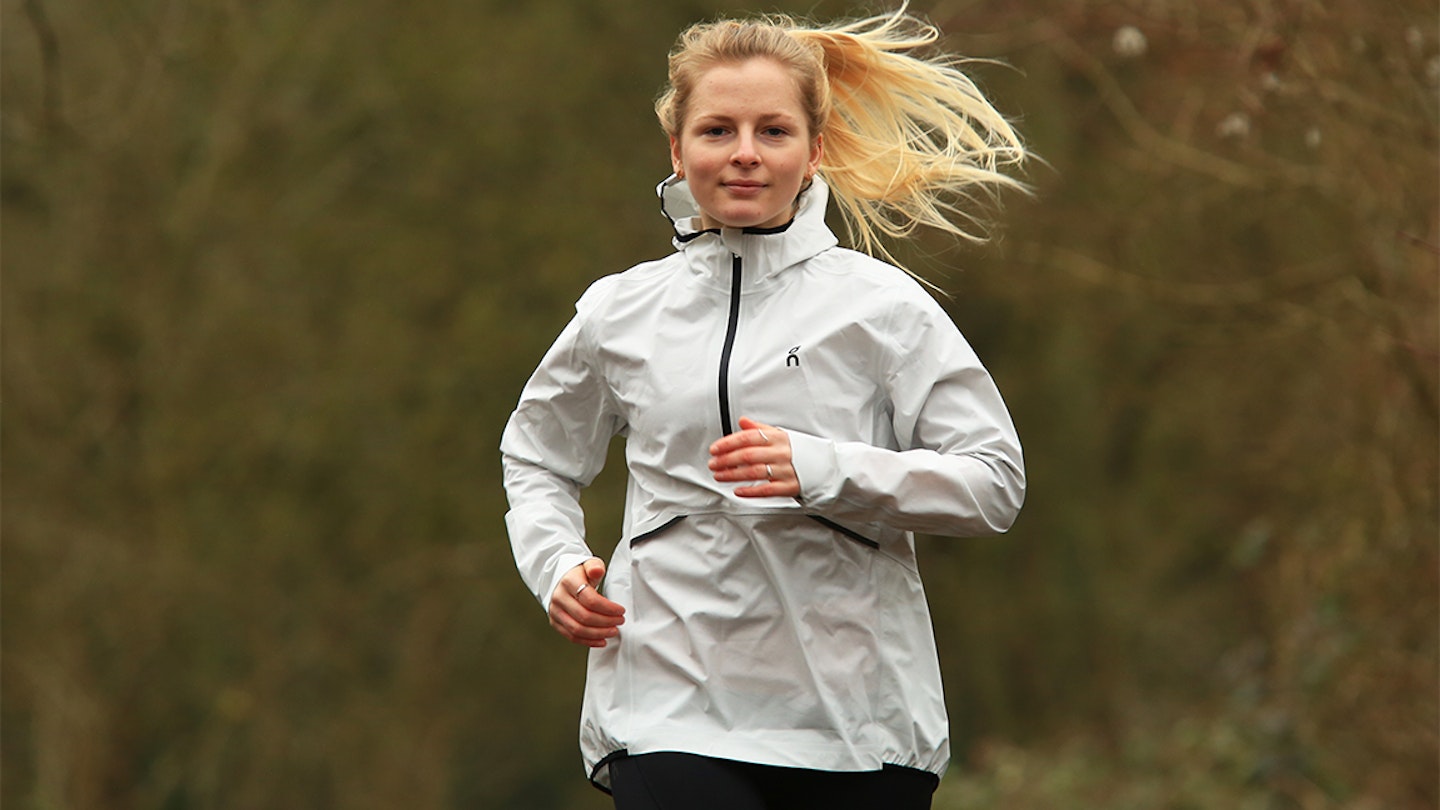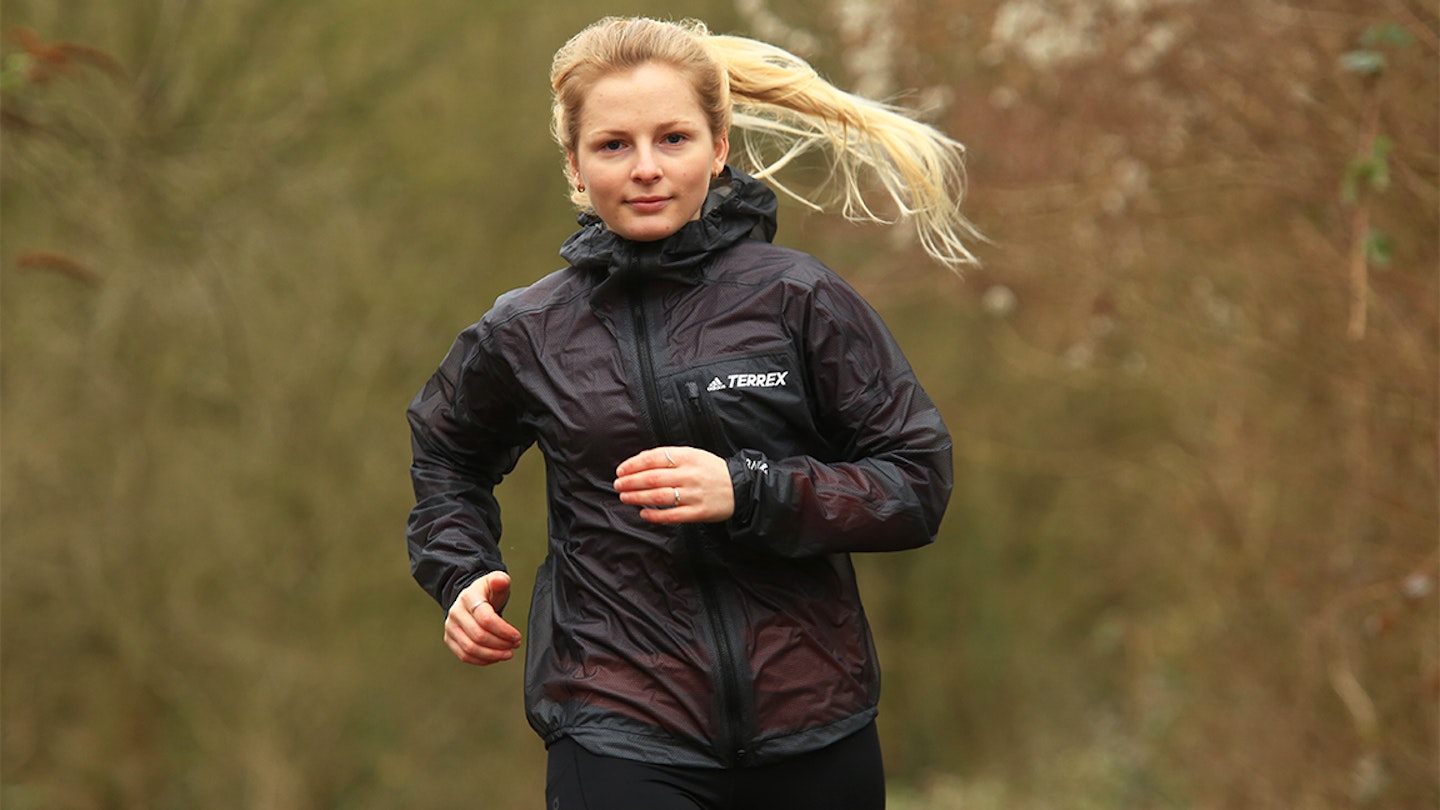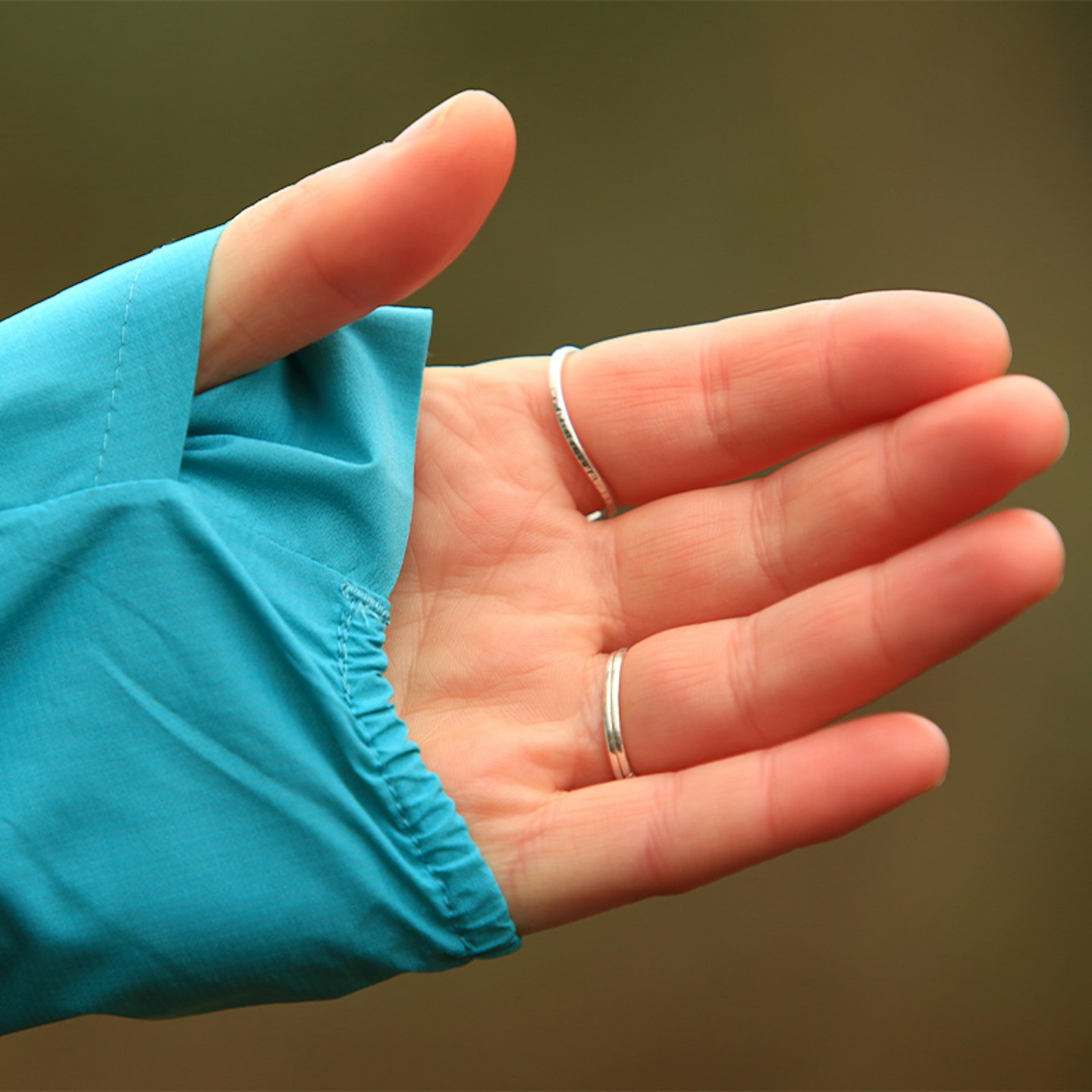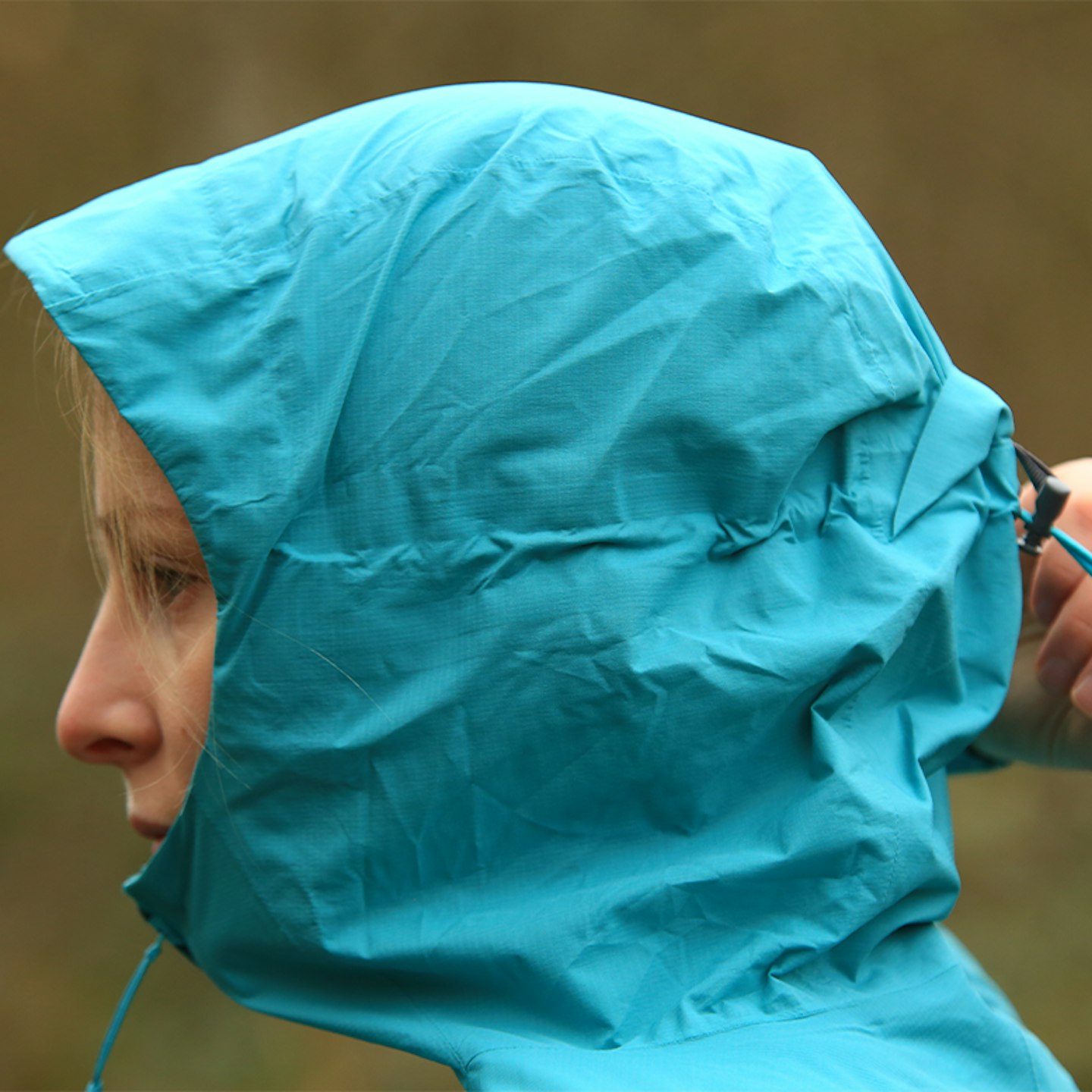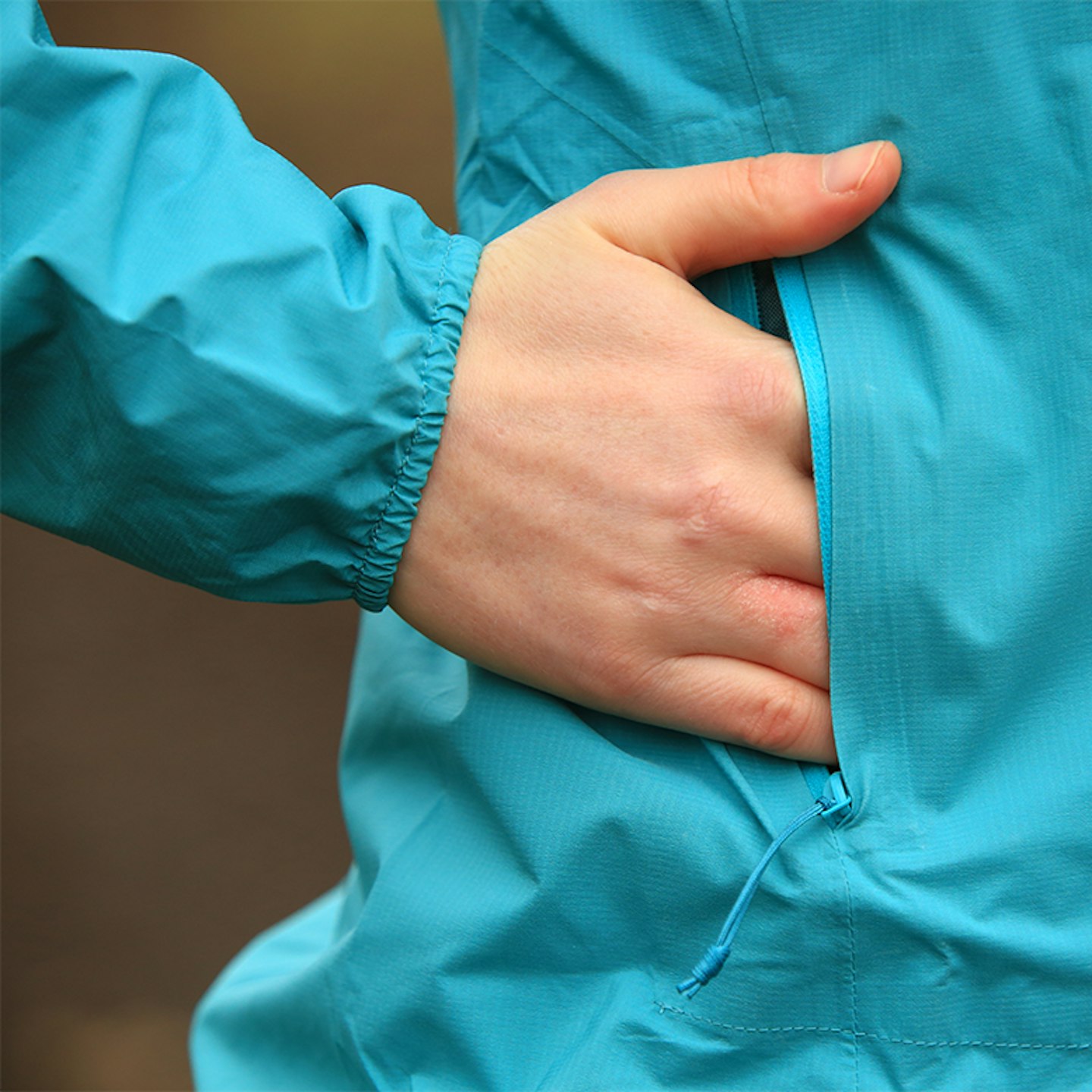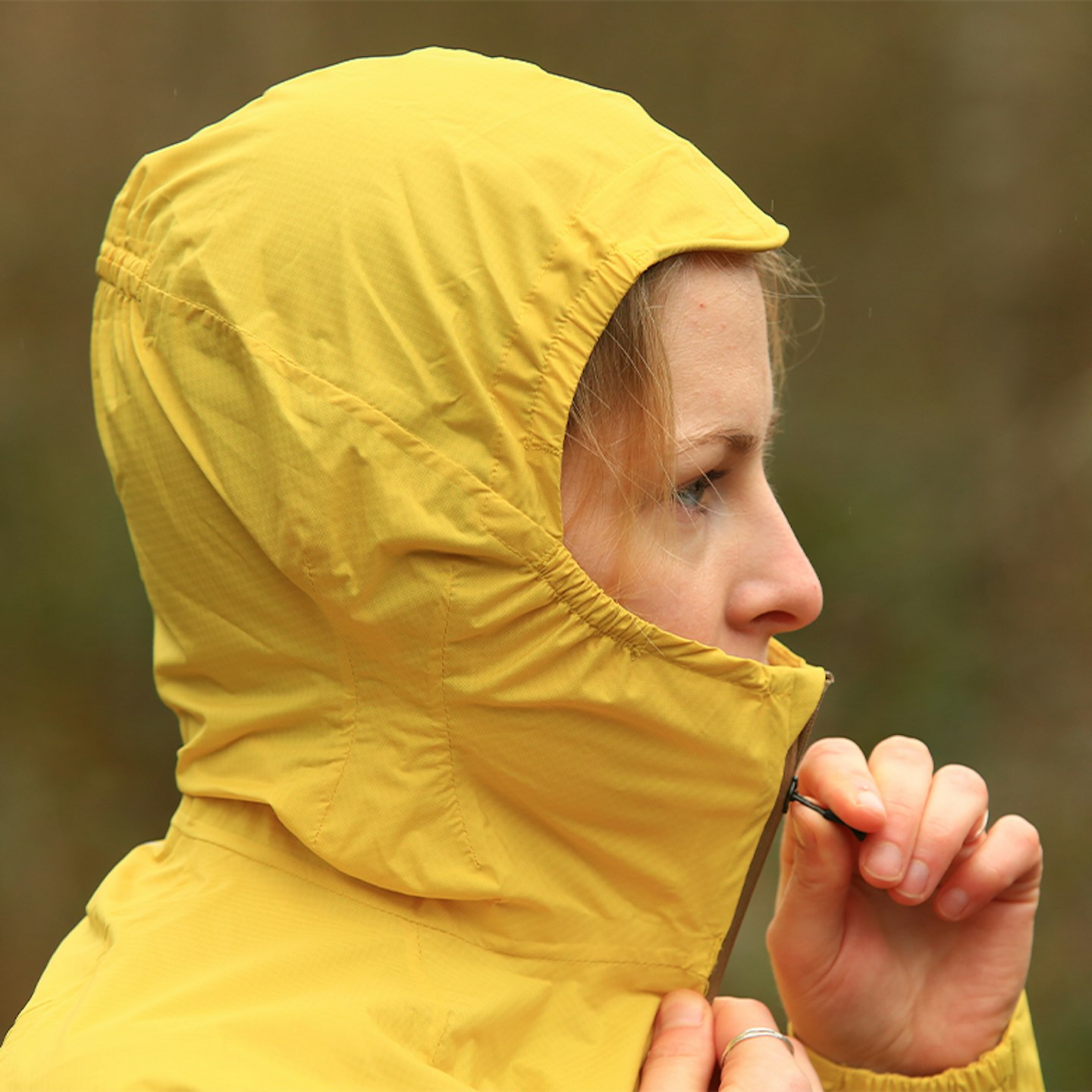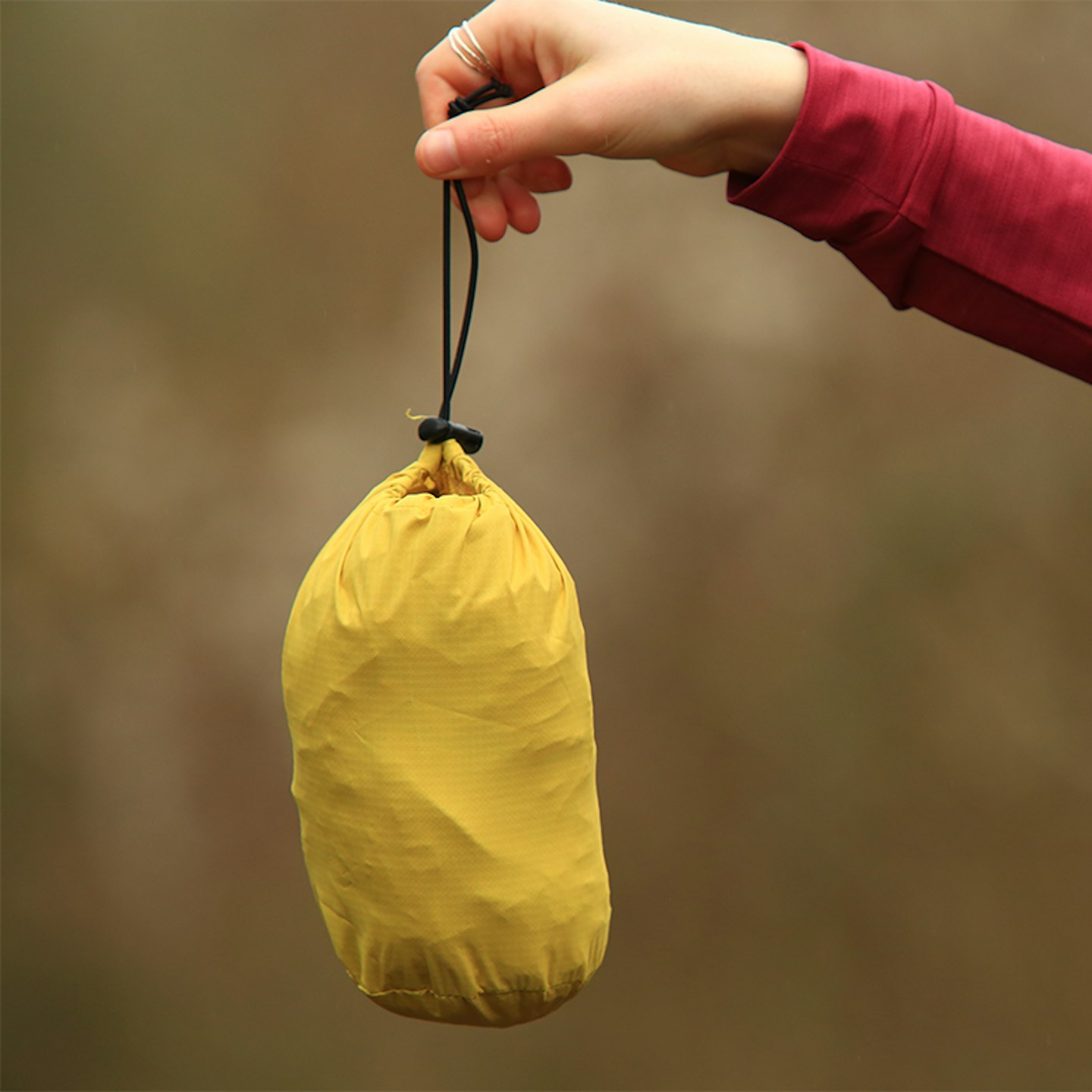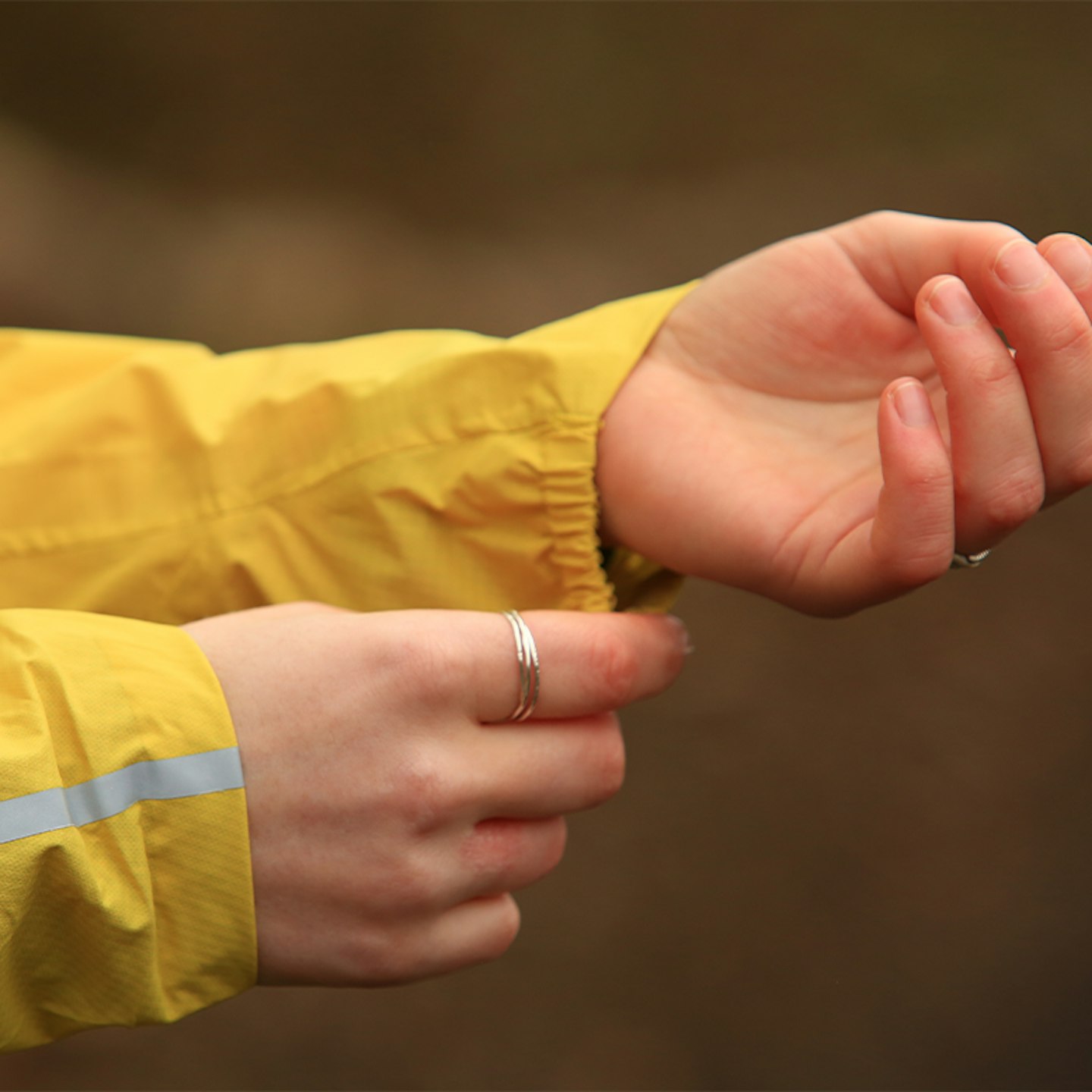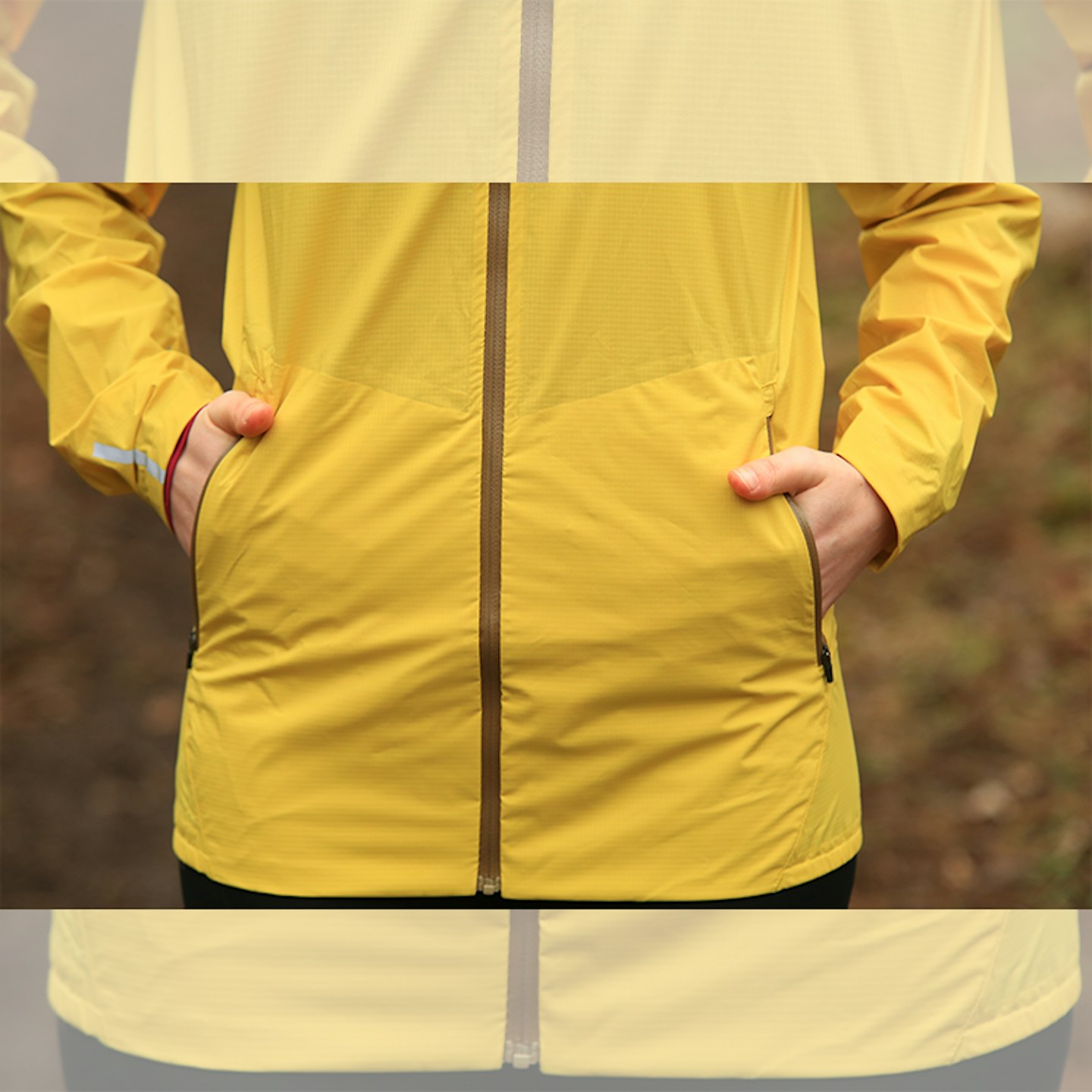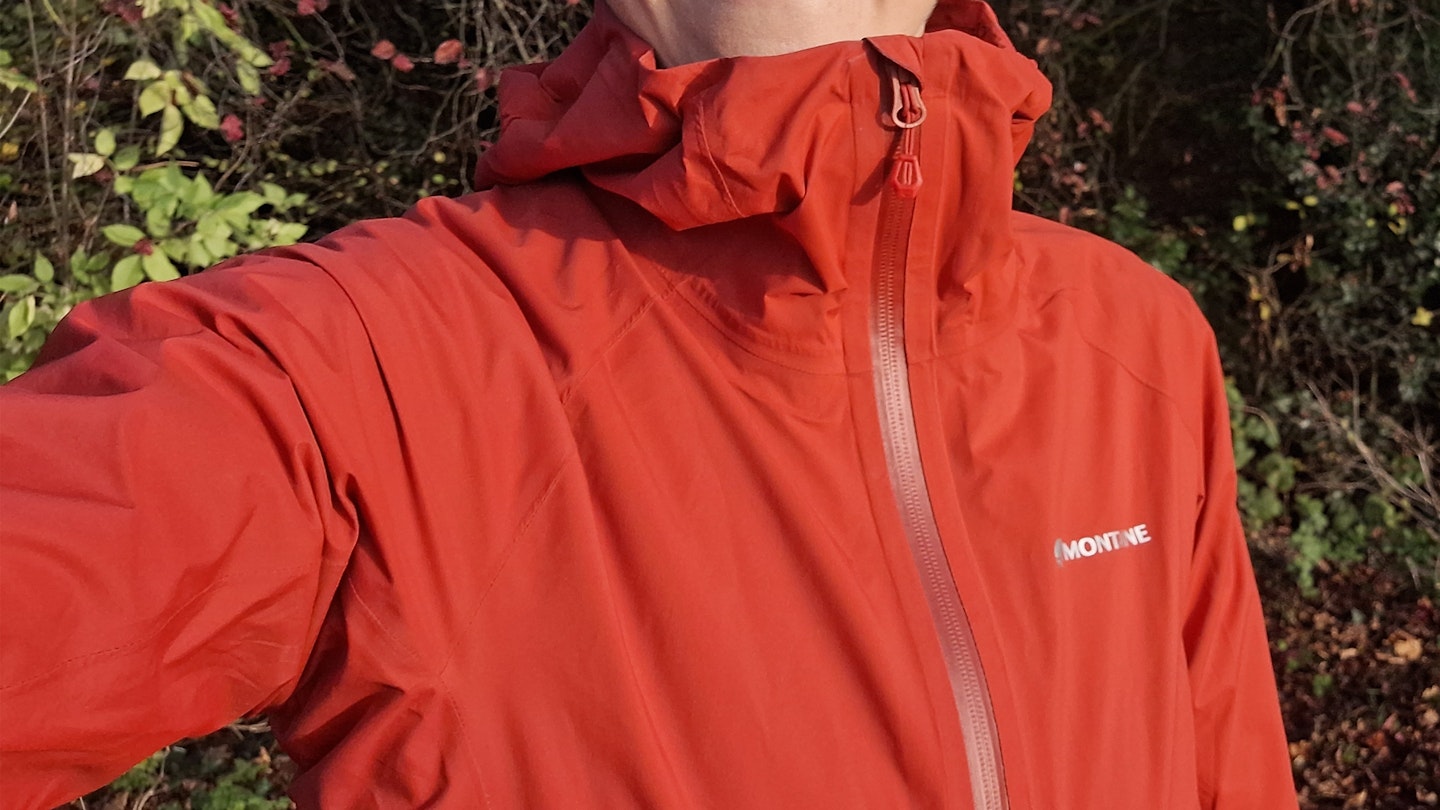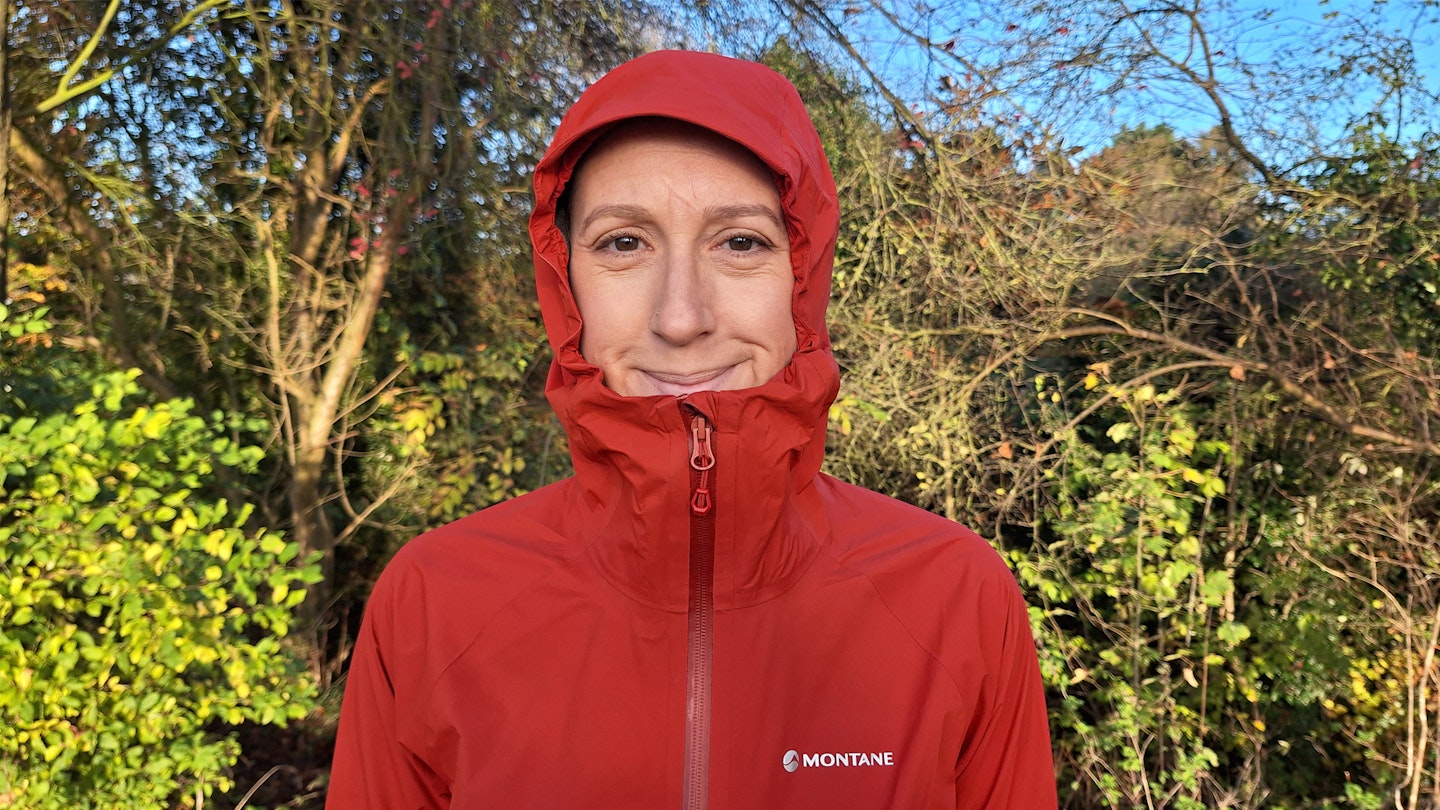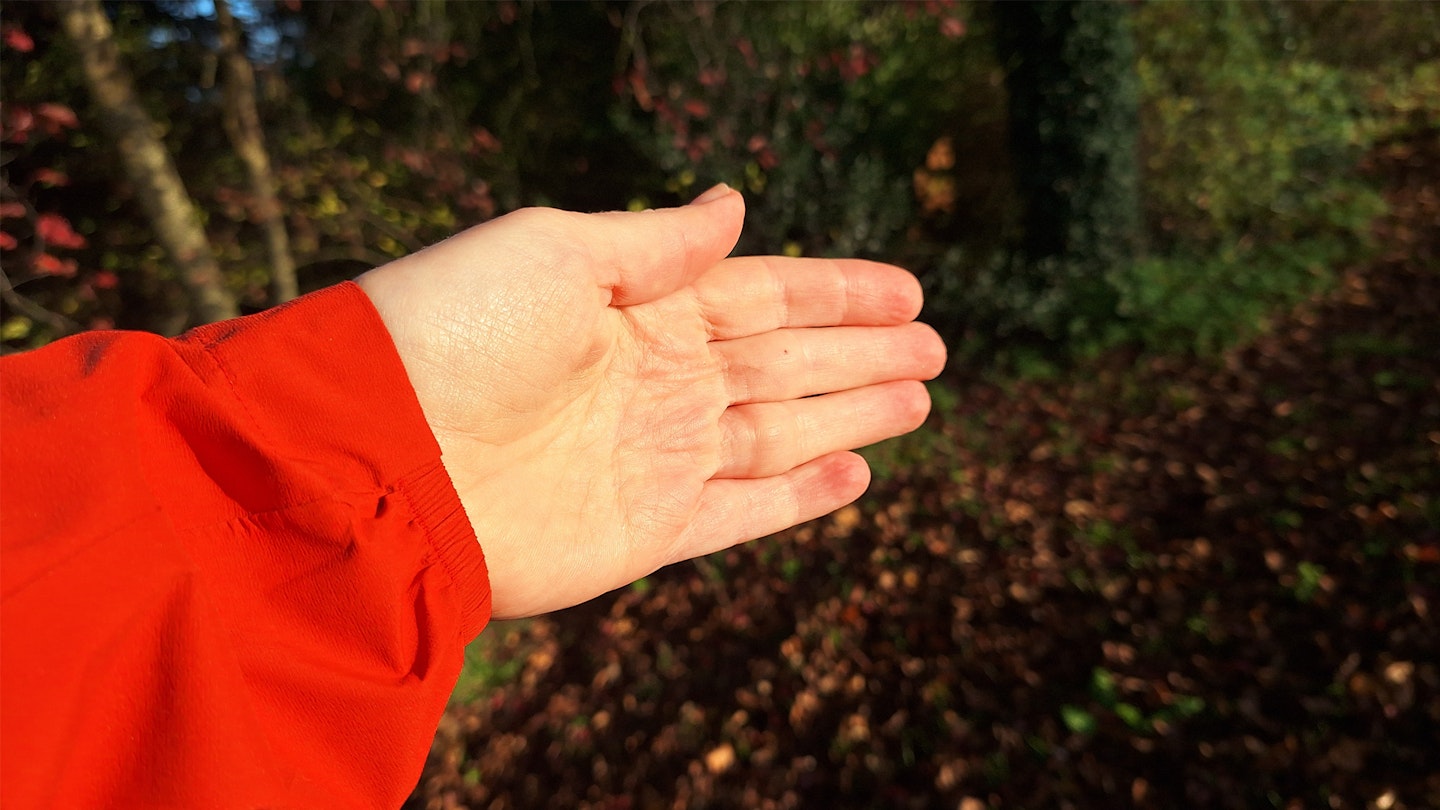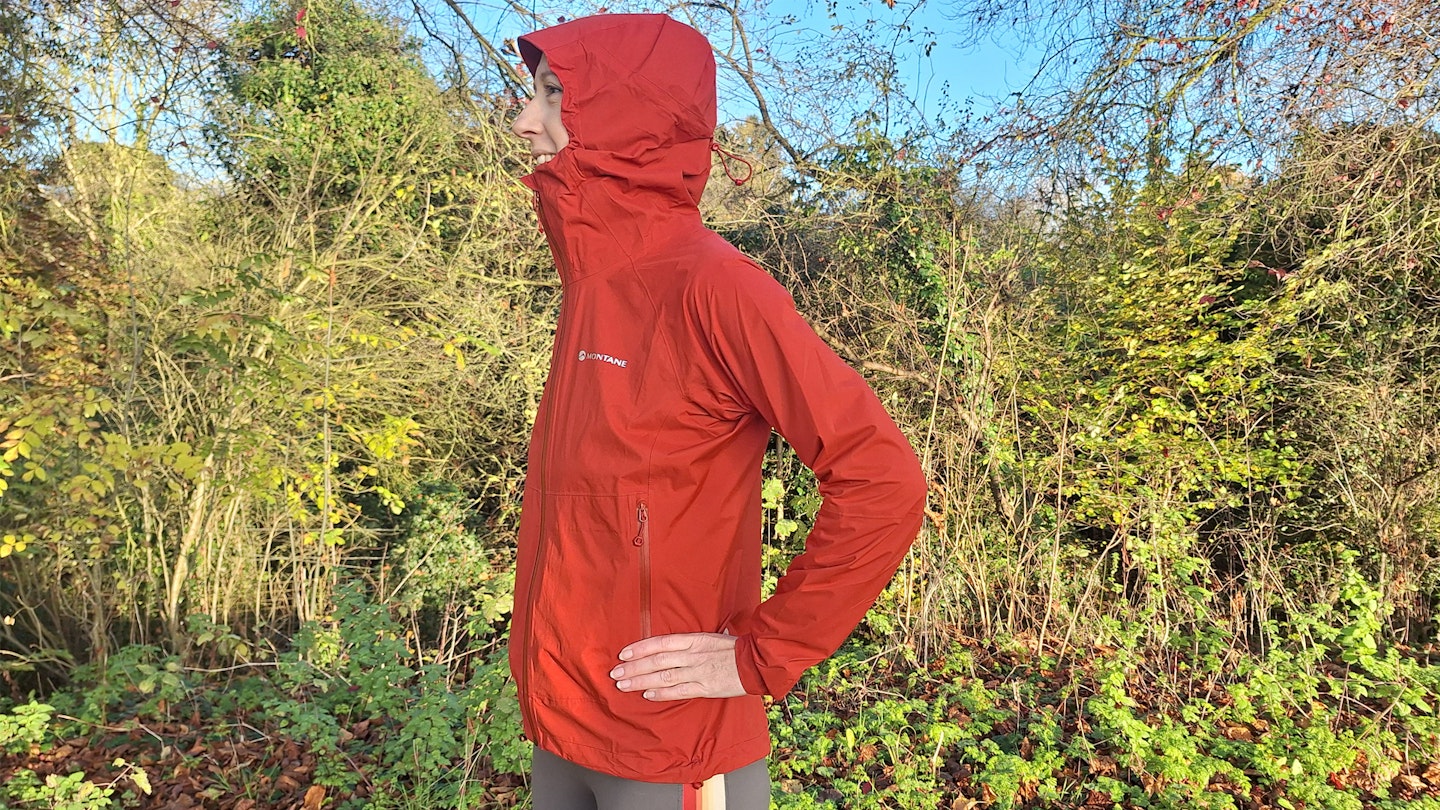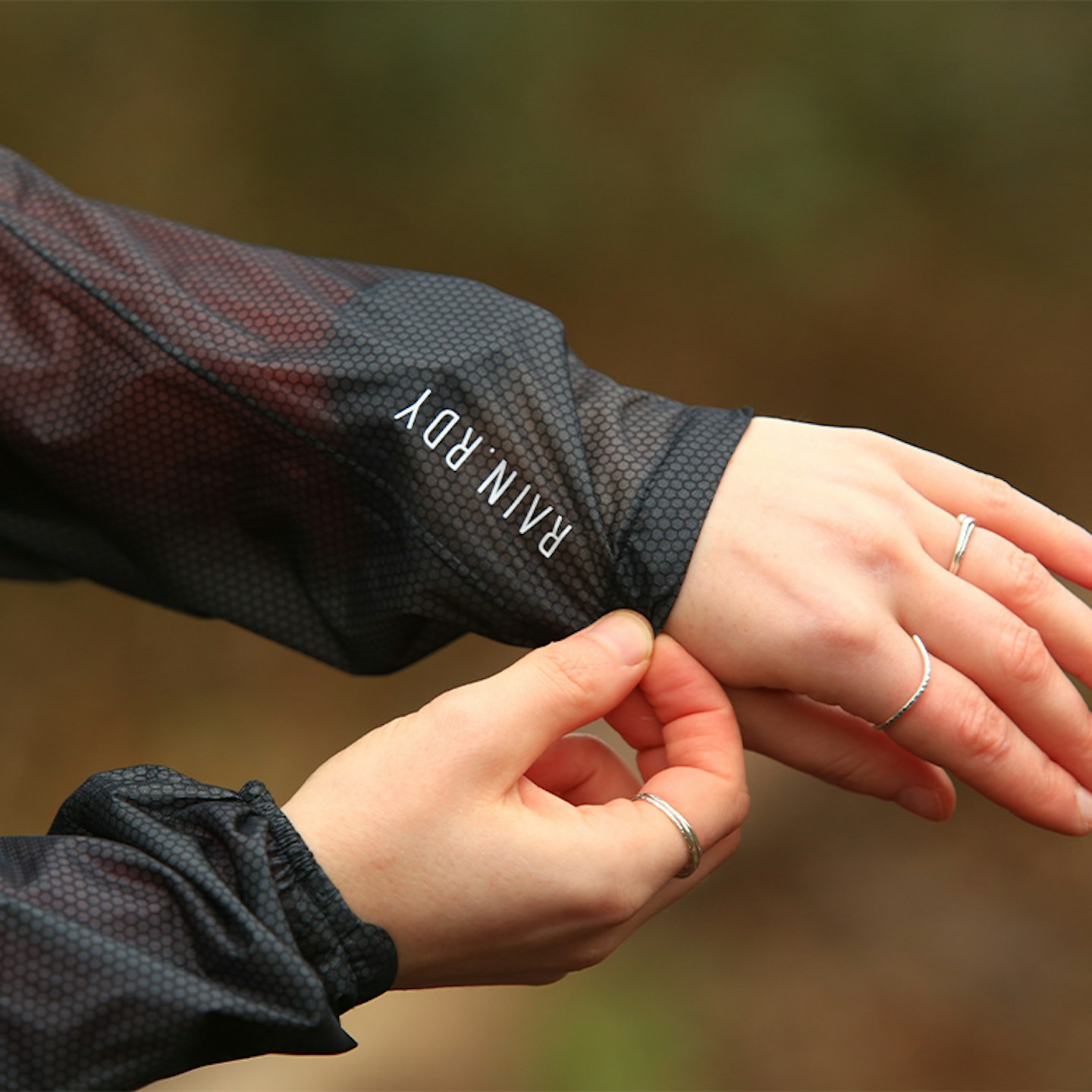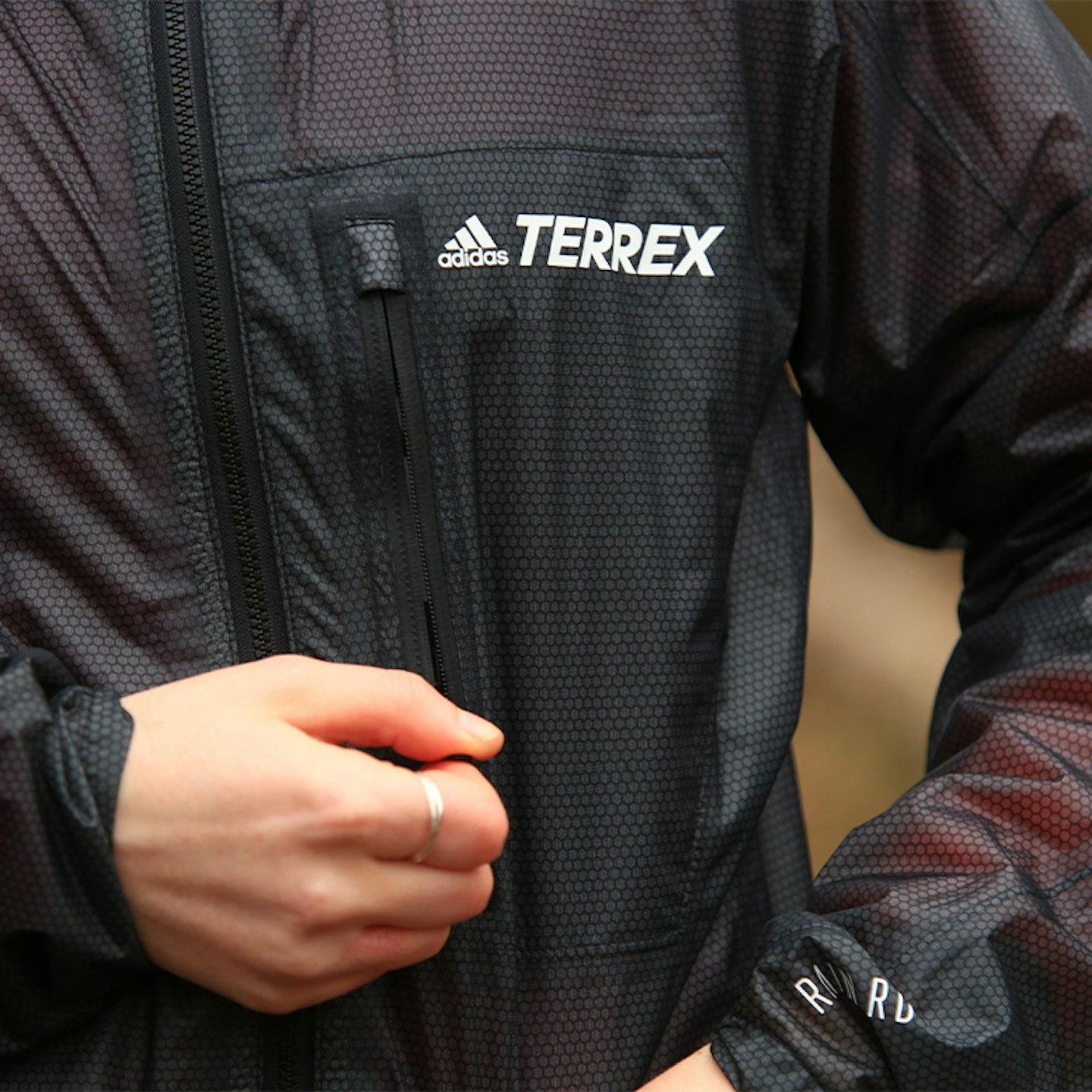A waterproof trail running jacket should be at the top of your essential kit list – well, maybe under shoes, but only just!
Training in the rain is pretty unavoidable. What you can control is what you wear. Investing in a high-quality waterproof will transform your running experience and keep you exploring the trails all year round.
What are the best waterproof running jackets for 2025?
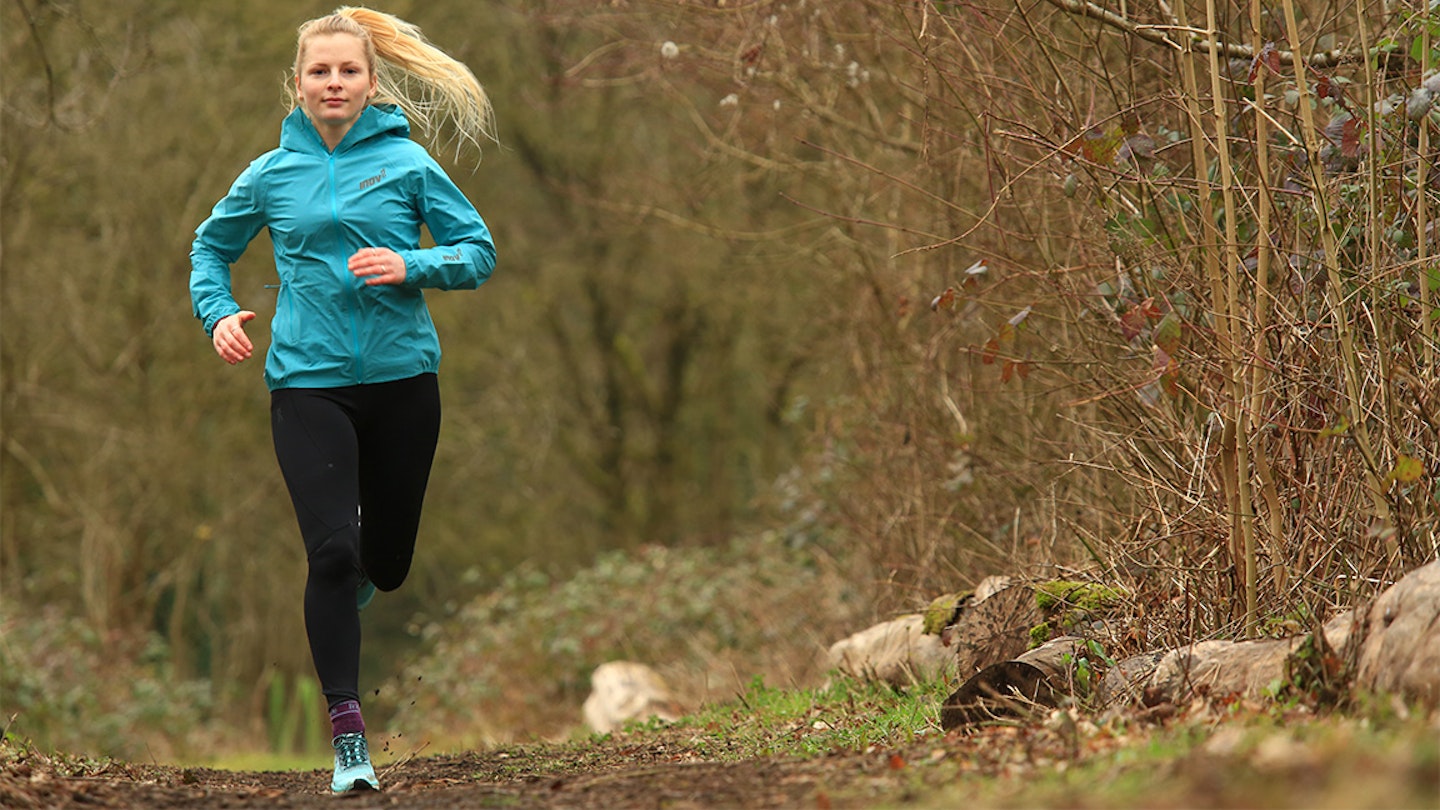
Best in Test: Inov-8 Stormshell
Best Value: Decathlon Evadict
Best for high performance: Compressport Thunderstorm
Best pack-down shell jacket: Rab Phantom
How we tested the best waterproof running jackets
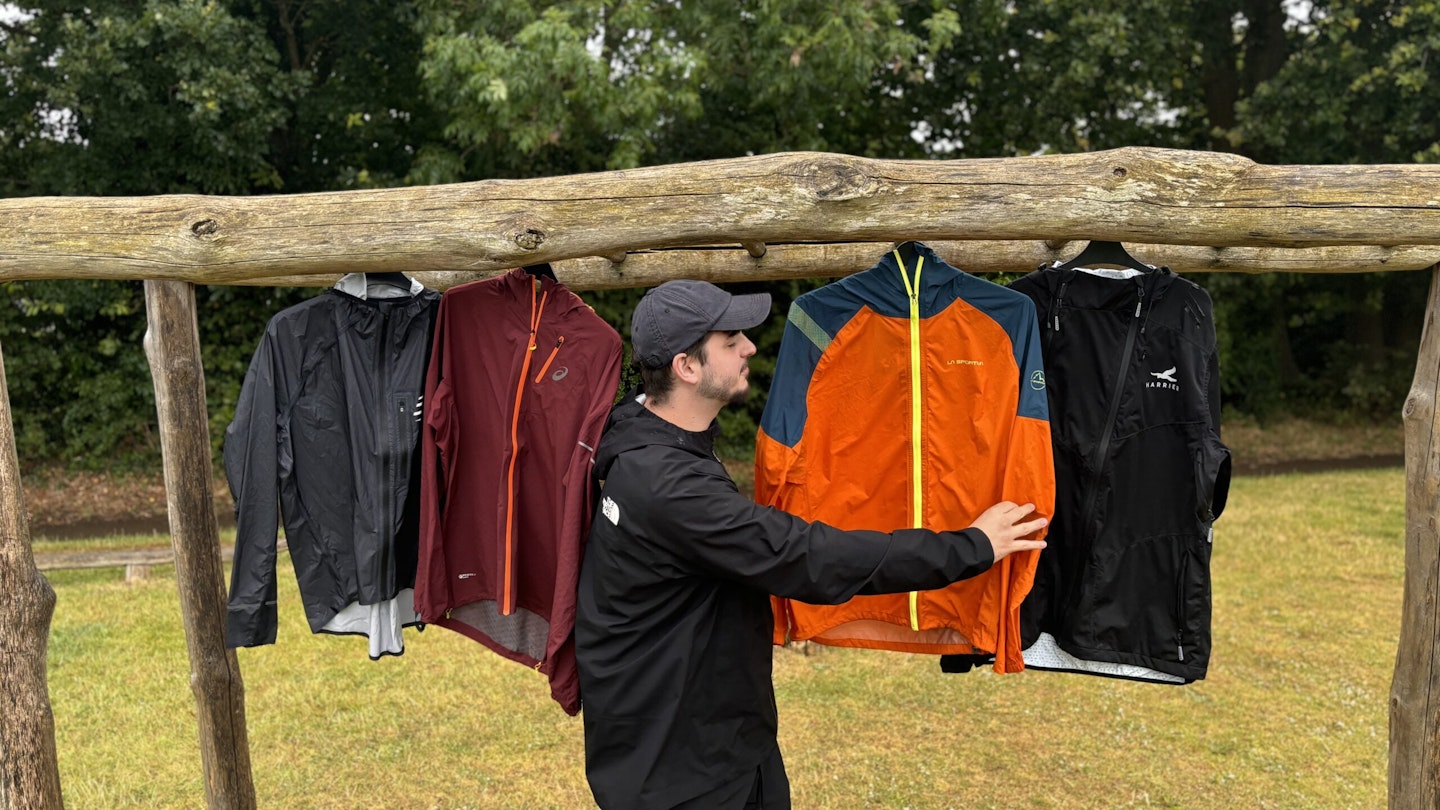
We've been testing waterproof jackets as winter continues to batter the UK with it's usual torrential fury. Naturally, the best running rain jackets tick a lot of boxes. They need to have an excellent waterproof membrane while retaining a good level of breathability and comfort, which is certainly not an easy balance to strike.
We look for a variety of features in a running rain jacket, but top of the list has to be waterproof and water-resistant capabilities. It might not always be raining though and just because it's raining, doesn't mean the temperature in the single digits. Hence, we also must consider breathability, range of movement, weight, and fit when choosing a waterproof running jacket that needs to be both comfortable and functional.
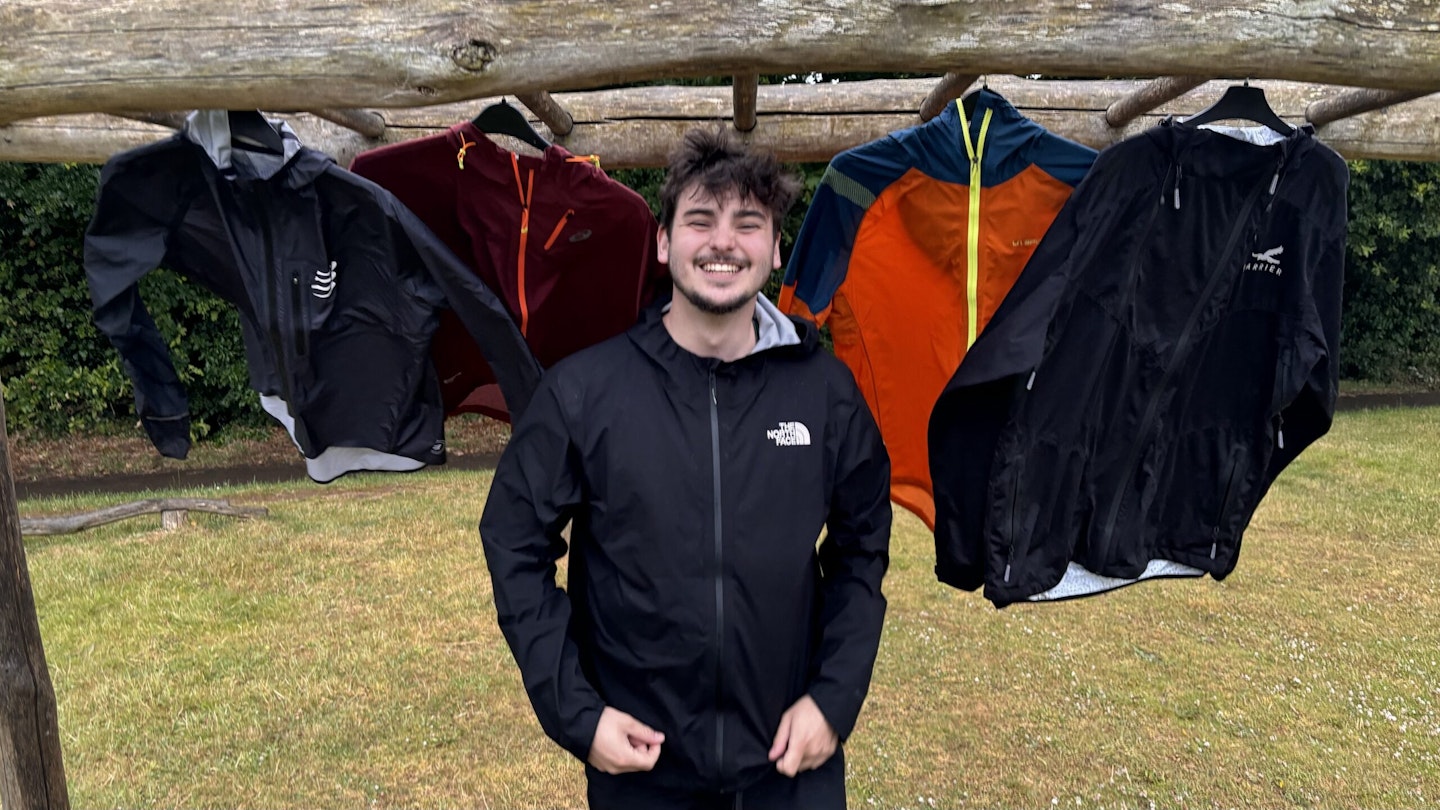
In particular, a good waterproof jacket will have features designed to keep the rain out. These include the all-important taped or bonded seams to seal out any water ingress through seam stitchings. Go for a jacket with cinched cuffs at the wrists and hem, with some form of adjustability like a drawstring or elastic to create a flush seal.
A high neckline gives you the option to really burrow away from the rain, and a hood can be a deal breaker for some - especially those with long hair! When it comes to a hood, look for one with some rigidity and sort of peaked 'cap' or wire set into the front to shelter the eyes from incoming raindrops. Again, adjustability is also key here to ensure the hood stays firmly in place and doesn't rustle. Along with your waterproof jacket, you'll want to consider levelling-up to some waterproof trail running shoes to keep you feet as bone dry as your top half while you run.
All of the rain jackets on test are made to withstand some level of downpour, keeping you as dry as possible as you run. Thankfully, there is a standardised means to measure the extent to which a material is waterproof, we call this unit of measurement the Hydrostatic Head (see the bottom of the article).
Read more about how we test HERE.
Best waterproof running jackets reviewed:
The Inov-8 Stormshell is aptly named and delivers on what it promises. Made to cope in the wettest conditions, the Stormshell is a performance-driven layer with a streamlined fit.
The structured hood keeps the rain off and out of the eyes, with a drawstring sinching the sides for adjustability. A high collar and zip create a secure fit, while soft lining inside the zip garage avoids any uncomfortable rubbing.
A light 150g, the Stormshell manages to remain fairly breathable in use, while also offering a high level of waterproofing thanks to the taped seams and waterproof Pertex Shield fabric. If the weather clears up, the one pocket at the front of the jacket can also be used as a stuff sack to pack it away and into a running pack.
Fit is comfortable, offering a slim silhouette without being restrictive. The partly elasticated wrists and hem keep the jacket in place well, though the sleeves seem to fall a little short to make comfortable use of the thumb loops.
Pros
- Fully waterproof
- Lightweight
- Well-fitting
Cons
- A little pricey
- Only one pocket
| Women's sizes | UK6 - UK16 |
| Men's sizes | XS - XL |
| Weight | 150g |
| Waterproofing | Pertex Shield, 20,000 HH |
| Construction | 100% Polyamide shell with PU membrane |
The Decathlon Evadict comes in at the budget end of our selection, yet it has many good features. At first sight, the yellow colourways and reflective stripes make the Evadict highly visible in poor weather conditions, which is always a big plus in our books for overcast and rainy running.
The Evadict has hydrostatic head of 10,000mm, which is the minimum you’d expect from a decent waterproof jacket. Taped seams and a taped zip provide weather resilience, but lacks of a full storm flap which might create a vulnerability in extreme conditions. Though the Evadict is pitched as a breathable jacket, the lack of ventilation and not so breathable material can trap some perspiration agains the skin, for this reason I’d don this jacket for colder trail runs as Decathlon suggests.
The hood has a peak and a high neck, which offer good protection from the elements. Though the lack of tightening system to the hood feels like an oversight. Moving down to the cuffs, the wrists are semi-elasticated to reduce water ingress and a dipped hem at the back of the jacket offers slight rear protection and stops it riding up when running.
In terms of pocket capacity, there’s two generous pockets on either side, which can be filled with all you need for a shorter run. Included with the shell jacket is a little stuff sack for packing it neatly away when not needed, and stashing in your running pack.
The sizing is generous, making it possible to fit a running pack underneath the shell later. But if you like a slimmer fit, I’d recommend you size down.
Pros
- Good value for money
- Decent waterproofing
Cons
- Lack of breathability or air vents
- No storm flap at zip
| Women's sizes | UK6 - UK14 |
| Men's sizes | S - XXL |
| Weight | 195g |
| Waterproofing | 10,000 HH |
| Construction | 2.5-layer with membrane |
The Montane Minimus Lite balances lightweight design with rugged waterproofing, making it a top choice for trail runners tackling unpredictable weather. Weighing just 215g (women’s size small), it offers a 20,000mm hydrostatic head rating and fully taped seams, effectively shielding you from moderate rain and snow. During testing, it kept tester Lily Canter warm and dry in temperatures below zero with only a single base layer.
Its standout features include a trim, stylish fit, lightweight packability, and an adjustable hood with a stiff peak for clear vision in harsh conditions. The nylon ripstop fabric is durable yet soft, with a stretchy design allowing for unrestricted movement. However, the jacket isn’t flawless—hood drawstrings can flap distractingly, and unzipped sides tend to billow.
Breathability is solid for a waterproof jacket, managing sweat better than cheaper options, though moisture can collect at the seams after extended runs. Sustainability-wise, Montane avoids PFCs, though the use of 100% nylon keeps the eco-rating low.
While pricier than alternatives like the Janji Rainrunner, the Minimus Lite justifies its cost with superior waterproofing, durability, and a flattering, versatile fit that performs as well as it looks. Ideal for those seeking style and substance on wet, rugged trails. A deserving winner in this list.
Read our full Montane Minimus Lite review here
Pros
- Stylish trim fit
- Warm and flexible
- Solid waterproofing
- Adjustable hood with stiff peak
- Lightweight and packable
Cons
- No option to clip back sides when partially unzipped
- Drawstring hood toggles flap in face
| RRP | £185 / $235 |
| Women's sizes | UK 6 - 16 |
| Men's sizes | XS–XXL |
| Waterproofing | Stretch fabric, 20,000mm |
| Weight | 215g / 7.6 oz (size 10) |
The Compressport Thunderstorm is a pricey but impressive ultra-light waterproof jacket for dedicated runners. Weighing a mere 126g, it’s engineered with high-end materials, boasting a 25,000mm waterproof rating that stood up to heavy downpours in our testing. The slim, athletic fit might not suit everyone, but we found it eliminated any wind drag, making it feel like a second skin on longer runs.
This jacket doesn’t feature any adjustable cuffs or hood toggles; instead, Compressport has opted for elasticated bands that stayed firmly in place without fuss. And despite its minimalist design, the Thunderstorm excelled in breathability, with a 75,000g/m² rating that kept us cool even on intense runs. We didn’t experience the clamminess that’s common with other waterproofs, which speaks to the fabric’s high performance.
However, the Thunderstorm isn’t without its drawbacks. It’s a snug fit, particularly around the chest and hips, so consider sizing up if you prefer a bit more room or plan on layering. Sustainability is also a letdown at this price point; while durable, it lacks eco-friendly credentials like recycled materials.
Overall, the Thunderstorm is a specialist jacket for those willing to invest in premium waterproof protection with unmatched breathability. It may not be for everyone, but if you’re after top-tier performance in a featherlight package, it’s worth the splurge.
Read our Compressport Thunderstorn 25/75 Waterproof Jacket: FULL REVIEW
Pros
- Excellent weather protection
- Precise fit is surprisingly unrestrictive
- Unmatched breathability
- Super lightweight
Cons
- Athletic cut won't suit everyone
- Hood and cuffs aren't adjustable
| RRP: | £300 / $420 |
| Breathability: | 75,000g/m² |
| Weight: | 126g / 4.4 oz |
| Waterproofing: | 25,000g/m² |
| Construction: | 100% nylon |
| Unisex sizes: | XS–XL |
The Harrier Exmoor is a seriously versatile waterproof jacket which really comes to life during all-day endurance training. Weighing in at 340g, it’s not the lightest option around, but that’s offset by the exceptional feature set. From the pleated back that accommodates a race vest underneath, to dual zips allowing easy access to gear and airflow, it’s clear this jacket is made for serious, all-weather adventures. During our weekend ultras, the Exmoor handled wet and windy conditions with ease, keeping us dry and comfortable.
One standout is the hood, which adjusts securely with three cinch points and a stiff peak that keeps rain out of your face. Plus, it packs a clever roll-down bumbag feature, so you can wear it around your waist when the rain stops. While it doesn’t compress as small as some lightweight jackets, we found this incredibly convenient for changeable weather.
Performance-wise, the Exmoor’s 15,000mm waterproof rating kept us protected during moderate-to-heavy showers, though the fabric did start to feel heavier in prolonged downpours. Ventilation is impressive, with pit zips, front vents, and a snap closure for secure, open wear—all adding flexibility in fluctuating conditions.
We recommend sizing up if you want to add layers underneath, especially if you’re wearing a pack, since the jacket did feel quite snug on our tester. Ultimately, while heavier and a bit bulkier than minimalist alternatives, the Exmoor’s durability, functionality, and sub-£100 price tag make it unbeatable for long, wet trail runs.
**Read our Harrier Exmoor Waterproof Jacket: FULL REVIEW
**
Find the women's version here
Pros
- Excellent range of features
- Durable construction
- Pleated back allows for packs to be worn underneath
- Dual zips for customised ventilation
Cons
- A fair bit heavier than other jackets
- If you stash anything in the pockets, they will jangle
| RRP: | £94.99 / $105 |
| Women's sizes: | XS–XL |
| Men's sizes: | XS–XXL |
| Waterproofing: | Stretch fabric, 15,000mm |
| Construction: | N/A |
| Weight: | 340g (12 oz) |
When you first get your hands on the Soar Ultra Jacket, you can instantly tell that it’s made to be a seriously piece of running kit. The Ultra is designed to be a high-performing and technical waterproof running jacket. In the Ultra, Soar has developed their own membrane-free, waterproof fabric dubbed Rainout, which makes for a lightweight (144g) and breathable jacket that’s still superbly protective in showers.
The woven knit fabric is created via a heat-shrinking process, which creates a dense weave. A Durable Water Repellent (DWR) coating is applied before and after this process, which Soar says results in the Ultra being both windproof and waterproof. Visible taped seams add to the waterproofing, as well as being a unique style feature.
A four-panel construction wraps the jacket round the body to create a slightly tailored fit, with partly elasticated wrists and a drawstring hem doing a good job of keeping the jacket in place. The jacket’s true to size, with a size S fitting as a UK8, while still allowing for room inside for movement and extra layers.
For such a waterproof and structured jacket, I’m impressed by the incredible flexibility and stretch in the lightweight material. Which does a good job at warding off rain for runs of up to an hour, while still managing to remain fairly breathable - an elusive combination in a rain jacket! Note though that there’s no hood, so if you like to run hood up in the rain, then take a look at our other waterproof jacket reviews.
Unusually, the Ultra has one pocket that’s located at the lower back. It’s easy to access on the go, so no qualms there, and has a large capacity with plenty of room for a phone, gels, keys and change.
Pros
- Technical features
- Good waterproofing
- Refelctive detailing
Cons
- Large price-tag
- Only one pocket
| Women's sizes | XS - XXL |
| Men's sizes | XS - XXL |
| Weight | 144g |
| Waterproofing | Rainout fabric |
| Construction | 2-layer |
The Asics Fujitrail is a highly adjustable, breathable running jacket designed to keep you comfortable on intense trail runs. We took it out in wet conditions over a 20km trail and found it excelled in ventilation and comfort, thanks to the Pertex Shield 2.5-layer fabric. This lightweight material offers a solid 20K/20K waterproof rating—perfect for moderate rain, though it can start to saturate in heavy downpours.
What sets the Fujitrail apart is its fit and adjustability. With a triple-adjustment hood, adjustable hem, and thumb loops, it moulds to your shape and holds firmly in place, ideal for technical terrain and long distances. The soft, malleable fabric also makes it feel less like a waterproof shell and more like a second skin, allowing for free movement without the stiffness found in many other jackets.
On the downside, it lacks ample reflective detailing, and the cut can feel boxy until adjusted. At £187, it’s a premium option, but discounts are available as newer models arrive. For runners prioritising airflow over full waterproofing, the Fujitrail is an exceptional pick; however, those seeking ultimate rain protection might look at alternatives like the Inov-8 Stormshell V2.
In all, this is a top choice for trail runners wanting a versatile, breathable layer, particularly for high-output runs in changing conditions.
**Read our Asics Fujitrail Waterproof Jacket: FULL REVIEW
**
Find the women's version here
Pros
- Highly adjustable fit
- Thumb loops are more comfortable than other jackets
- Exceptionally breathable with lots of ventilation
Cons
- Not much reflective detailing
- Can take some fiddling to get the fit just right
| RRP: | £187 / $215 |
| Women's sizes: | XS–XL |
| Men's sizes: | S–XL |
| Waterproofing: | Pertex 2.5 layer (20,000 HH) |
| Construction: | 100% nylon |
| Weight: | 161g / 5.7 oz (size medium) |
At first glance, the Rab Phantom appears pretty simple and straightforward. That’s because it is. But therein lies the beauty of it. At 70g, the Phantom must be the lightest waterproof layer we’ve ever tested, and that’s saying something.
Rab describes it as ‘the ultimate stash-and-forget’ shell and it fills this purpose down to a T, the whole jacket packing neatly into the tiny stuff sack provided, which is so small it’s the size of my palm - and I’ve got small hands.
Material used is 7D Pertex Shield 2.5L which Rab claims has a hydrostatic head rating of 20,000. Showers bead off the fabric pretty well, the waterproofed zip guard and taped seams adding that extra layer of protection. But the Phantom does struggle in the really heavy stuff, in these conditions we’d reach for the OMM Kamelika (see review above) or Inov-8 Stormshell for that extra ounce of protection.
The Phantom is a pull-on style with half zip. A true shell, there’s no pockets on the jacket whatsoever, but this doesn’t make it devoid of run-specific features. The bottom and wrist hems are partly elasticated, which keeps everything in place while leaving room for manoeuvre.
The hood has a ultra-thin wire threaded through the peak it to give some slight structure, while the high neck allows you to zip the coat all the way up to your nose for protection in really foul conditions. When not needed, the hood can be hooked away at the nape, but there’s really no need as there’s no rustle or bounce when running hood-off.
Pros
- Extremely lightweight and compact
- Great race-mandated waterproof
Cons
- On the spendier side for a shell
- Can’t cope with heavy downpours
| Women's sizes | UK8 - UK16 |
| Men's sizes | S - XL |
| Weight | 70g |
| Waterproofing | Pertex Shield, 20,000 HH |
| Construction | 2.5-layer |
The North Face Summit Superior Futurelight Jacket is a top choice for trail runners prioritising breathability and comfort over full weather protection. We tested it in mixed weather and found it excels in keeping runners cool and comfortable, especially during high-intensity runs. The Futurelight 3L shell provides good airflow, preventing overheating without compromising on light waterproofing. However, its protection in heavy rain isn't on par with more robust jackets like the Compressport Thunderstorm.
The 100% nylon material is soft and flexible, allowing for unrestricted movement which is perfect for the arm-flailing fun that comes with technical terrain. The hood cinches tightly, and the internal pocket doubles as a stow pocket, ideal for packing it down when not in use. While the open neckline enhances comfort, it does expose the neck to rain, which can be a drawback in harsher weather.
Sustainability-wise, The North Face uses innovative nano-spinning for the Futurelight fabric, reducing waste. However, it's not fully recycled, which might deter some eco-conscious buyers. At £270, it’s a premium option, but for those seeking a jacket designed for high-output activities like alpine trail running, it’s worth the investment. It doesn't offer full weather protection, but for moderate conditions and those who overheat easily, it’s a solid pick.
**Read our North Face Summit Superior Futurelight Jacket: FULL REVIEW
**
Find the women's version here
Pros
- Material is seriously comfortable
- Unrestricted movement in the arms
- Easily adjustable hood
- Comfortable neckline
Cons
- Cuffs can't be adjusted
- Lower neck line is less protective against rain
| RRP: | £270 / $300 |
| Women's sizes | XS–XL |
| Men's sizes: | S–XL |
| Weight: | 230g (size medium) |
| Waterproofing: | 3 Layer shell with Non-PFC DWR Finish |
| Construction: | 100% recycled polyester |
This suave and streamlined number from Under Armour (UA) is a comfy and practical everyday sports jacket with a peppering of run-specific features. As the name suggests, this jacket is designed to outrun the storm, not to weather it. Translated, this equals a combination of features to boost comfort - four-way stretch and lightweight construction - with ample breathability provided from the vents along the back and woven fabric.
Though the jacket is not fully waterproof, it aims to be water-repellent and was fairly protective in brief and light showers. This is partly due to the wind-resistant material and solid build. However, it doesn’t manage against heavy or sustained rain, so would be best suited to a cloudy day when showers are only a possibility.
UA describe the OutRun jacket as having a streamlined fit, which feels pretty accurate. There’s enough room for a
running t-shirt and base layerunderneath, and a drawstring waist offers a choice of fit, allowing for full range of movement when running.
The bungee adjustment on the hood is so subtle, we almost missed it, but it emulates the thoughtful details strewn throughout. These include the two hand-sized pocket at the front, one with an inner mesh compartment the ideal size for keys, and the smattering of reflective detailing on the front and back.
Pros
- Affordable
- Stylish
- Range of uses
Cons
- Not fully waterproof (doesn't claim to be)
| Women's sizes | XS - XL |
| Men's sizes | S - XXXL |
| Waterproof | Water-resistant |
| Construction | 87% Polyester / 13% Elastane |
The La Sportiva Pocketshell really impressed us with its eco-friendly design, top-notch ventilation, and solid waterproofing. Built with ultra-marathon runners in mind, this jacket combines durability with a light, compact build that’s perfect for long, wet runs. At 194g, it’s easy to pack down, yet robust enough to handle tough conditions, thanks to reinforced shoulders and a peaked hood that keeps rain out of your eyes.
In our testing on rainy trails, the Pocketshell’s Pertex Shield 2.5-layer fabric held up brilliantly, with rain beading off even in heavy downpours. However, after prolonged exposure, the material did start to saturate. The ventilation system is a standout feature—mesh-lined armpit vents with outer folds kept us cool without letting in water, which felt like a big upgrade from the usual zip vents.
Sustainability is a major plus here too, as La Sportiva used 100% recycled materials for both the outer layer and membrane. This eco-friendly approach sets it apart from other jackets like the Patagonia Storm Racer and The North Face Summit Superior.
A couple of minor trade-offs: the cuffs and hem aren’t adjustable, and we found the jacket better suited to mild weather since it doesn’t offer much warmth on its own. Still, for serious trail runners who value breathability, waterproofing, and eco-conscious design, the Pocketshell is a fantastic investment.
**Read our La Sportiva Pocketshell: FULL REVIEW
**
Find the women's version here
Pros
- Made with 100% recycled materials
- Durable construction for more longevity
- Smartly designed armpit vents
- Great neck coverage
Cons
- Not as much reflective detailing as we'd like
- Cuffs aren't adjustable
| RRP: | £167 / $159 |
| Men's sizes | XS – XL |
| Women's sizes | XS – XL |
| Waterproofing | 20,000mm HH |
| Construction | Main: 100% Recycled Polyamide. Membrane: 100% Recycled Polyester + Silver Print |
| Weight | 194g / 6.8 oz |
The On Running Waterproof Anorak is a triple-layer design with a focus on providing full weatherproofing and performance to the user. The three-layer membrane is waterproof with a rating of 20,000HH, which is maintained via the taped seams and water-repellent coating. It also sports hydrophilic elements in the lining, which draws moisture from the body, allowing you to sweat in complete freedom with no repercussions on performance.
Breathable and soft, the anorak design is a snug fit to pull on and off when on the move. It sits well against the body and has a longer hem at the back which gives a streamline feel for faster running. A short half zip on the front has a built-in storm flap allow for minimal water entry.
Large rear ventilation slits and two smaller front ones are a bonus and help to circulate the air through the jacket. Though if you’re running with a pack, these will effectively be blocked at the rear. Another drawback I found was the lack of pockets, which meant there was nowhere to stash valuables. Despite this, the jacket does have the function to pack away into its own inner pocket at the hood.
The cuffs are a good design, being stiff at the front and allowing for run-off of water. Meanwhile, a peaked hood design for foul weather stays in place and is adjustable, but not enough for optimal closure, which results in the wind and rain finding its way inside in really harsh weather.
Pros
- Lightweight
- Good waterproofing and breathable
- Well designed cuffs
- Stylish and unique look
Cons
- Vents useless with a backpack
- No pockets
- Hood adjustment leaves gaps for elements
| Women's sizes | XS - XL |
| Men's sizes | S - XXL |
| Waterproof | 20,000 HH |
| Construction | 3-layer |
Adidas have produced a super lightweight waterproof jacket in the Terex Agravic 2.5. First off, though no hydrostatic head is quoted for the RAIN.RDY material, I found the waterproofing to be very good, with taped seams adding the necessary reinforcement.
The jacket’s comfortable material stretches well and moves with the body as you run, though I did find the size S to be rather on the spacious side for a ‘slim fit’ shell. I’d err towards wearing the Agravic for colder runs as the lack of ventilation led me to get warm fairly quickly.
Though the high neckline does help to keep the hood in place, I did find the hood problematic in use as its looseness with no means of adjustment meant that the wind and driving rain had ample opportunity to enter the jacket.
As for design, the jacket’s slightly longer front allows the water run right off it, with elastic cuffs going a good job of repelling water entry. A storm flap behind the zip and front pocket are positive features and aid overall robustness. There’s one pocket available on the front breast which is handy for valuables and also doubles up as a pocket to pack it away.
The Agravic’s 360-degree reflectivity makes the jacket stand out and I was more confident running in low visibility – other more vibrant colourways are available too.
Pros
- Insanely lightweight
- Pocket fits a phone
- Packable shell
- Quick drying
Cons
- Hood gapes and isn't adjustable
- Questions over durability
| Women's sizes | XS - XL |
| Men's sizes | XS - XXL |
| Waterproof | RAIN.RDY fabric, 10,000 HH |
| Construction | 2.5-layer |
A funky looking disco green jacket, the Outdoor Research Helium Rain Jacket its sure to draw attention. The shell jacket provides a standard fit, which allows enough space to wear a small pack underneath.
There’s a good level of waterproofing at 20,000HH thanks to the Pertex Shield Diamond Fuse technology with taped seams, which allow for comfortable running in adverse weather, although some vents for breathability would have increased this. Diamond fuse technology improves durability, abrasion resistance and make the fabric stronger, while weighing in at a tiny 152g.
Drawstrings aid a snug comfortable hood, with an ample stiffened peak to repel wind and rain. The cuffs however fall prey to a lack of adjustability, the half elasticated design translated to water creeping in a little. A drawstring along the bottom hem of the Helium allows for a snug fit around the hips, keeping out the elements.
The partial storm flap means that the zip area is vulnerable to water entry, although an aquaguard coating should aid reinforcement at this area, and only time will tell how effective this is. Over the month of testing, we did find these held up to the test. Perhaps due to this coating though, I did find the zip itself to be rather stiff and cause the body of the coat to curl and fold when done up.
At the end of the run, rest assured a small pocket with a tether hook for a car key means you won’t be hitchhiking home! Such a small but useful feature, it's surprising more manufacturers don’t include this detail.
Pros
- Good looks and style
- Waterproof
- Key pocket
- Super lightweight
Cons
- Cuffs not completely protective
- Pocket capacity limited
| Women's sizes | XS - XXXXL |
| Men's sizes | S - XXL+ |
| Weight | 159g |
| Waterproofing | Pertex Shield, 20,000 HH |
| Construction | 2.5-layer |
What to look for in a waterproof running jacket
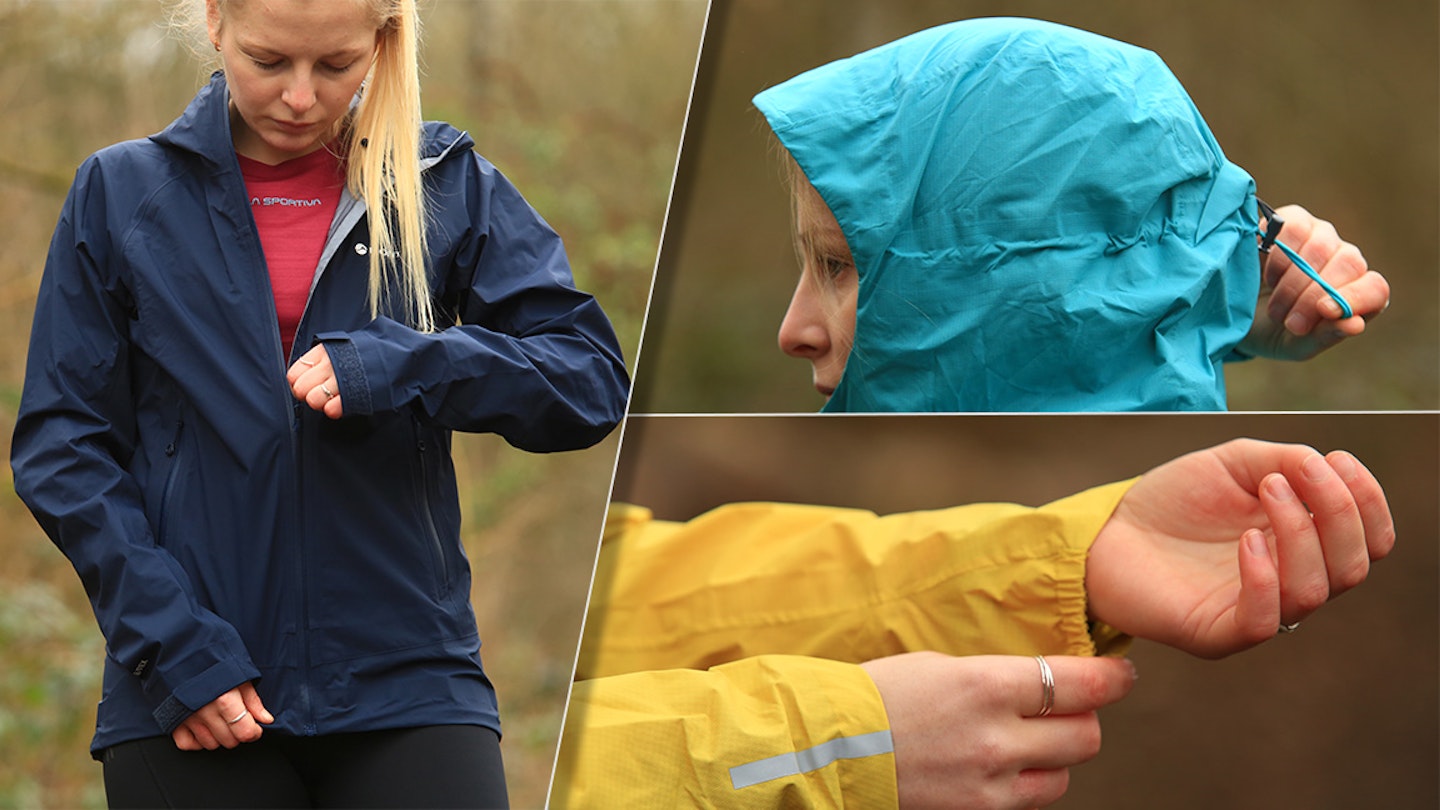
Waterproofing: Jackets will come in varying levels of waterproofing, which is measured by their hydrostatic head (HH) rating. Premium-end gear has a 20,000mm HH or higher, which means a 20m column of water can stand on the fabric before water penetrates it. The minimum you would want for a rain jacket is 10,000mm HH.
What is Hydrostatic Head? The Hydrostatic Head (HH) of a material is the height at which a column of water must be held against a fabric, before the build-up of pressure that's created causes the water to start penetrating the material. These days, the test is carried out using a water pressure machine which can replicate the downward pressure created by such a column. Typically, the tighter the denier weave of the fabric, the less moisture that's let through.
In the UK, companies are allowed to claim that a garment is waterproof if it has a HH of at least 1500mm. However, we'd recommend you reach for a waterproof jacket with a HH rating of at least 10,000mm, if not 15,000mm. A high HH would be 30,000mm, which means that the fabric let through water only once the column of water pressure reached 30m high. In other words, this fabric has a high level of waterproofing.
Seams: For a garment to be fully waterproof, its seams must be properly sealed so no water can penetrate to the layers below. This means that the seams must be reinforced to keep the rain out, this can be from taping to cover up the tiny holes left in the material from stitching, or welding the seams which should create both a watertight and airtight seal.
Breathability: Waterproof jackets struggle to be breathable as waterproofing creates a seal against the elements, which can also reduce airflow as well as water ingress. Look out for features like breathable materials, vents which can be opened during a break in the clouds, and thinner materials which will be more breathable than layers with thick waterproof membranes.
Hood: Some runners don’t like running with a hood, if you like the coverage though, a well-structured hood will keep you even more dry on a rainy run. Look out for internal wiring and structure to the tip of the hood to keep rain off your face, plus adjustability with drawstrings on the side along with a snug fit to keep the hood in place.
Cuffs: Look for jackets with some form of closure along the cuffs to keep the rain out. This could be with a drawstring, elasticated hem, or cuff that keeps the end of the sleeve tight to the wrist.
Zips: A zip is a point of weakness in a waterproof garment as this is an area where rain could seep through. A waterproof jacket should have reinforcement along the zip, which could be in the form of a waterproof coating, or a long zip baffle to provide an extra layer between yourself and the zip.
Visibility: It’s likely that with rain will come conditions of low visibility. Grey and dim cloudy skies will make you far less visible to traffic and other runners, so having a jacket with some touches to boost visibility is always a plus in our books. This could mean a completely fluorescent colourway or be in the form of more subtle reflective details.
About the authors
This group test covers the best waterproof running jackets for men and women. As such, we've used two testers.

Milo Wilson is our current trail running guru and is the world's fussiest jacket reviewer. He runs hot, hates sticky membranes, and refuses to look stupid. This means his criteria for a good running jacket is wildly harsh – but it also means that any jacket on this his is guaranteed to be extremely breathable and have a great fit.
Kate Milsom specialises in trail running content. In her career as a sports journalist, Kate has worked with industry-leading titles including 220 Triathlon, Cycling Plus, Road.cc and Cyclist. Prior to this, Kate studied English Literature and French at university, then got the outdoors bug and never looked back.

